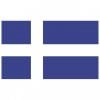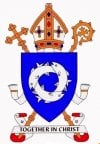Blog
World War Two
22 Nov 2024
I am grateful to Samuel Sjoberg, author of "Air Raid Islands: The Luftwaffe over Shetland during World War Two" (privately published, 2020) for sharing with us information on three Catholic servicemen whose funerals were conducted at St Margaret's Church between 1939 and 1942. They are all buried at the Knab Cemetery, Lerwick.
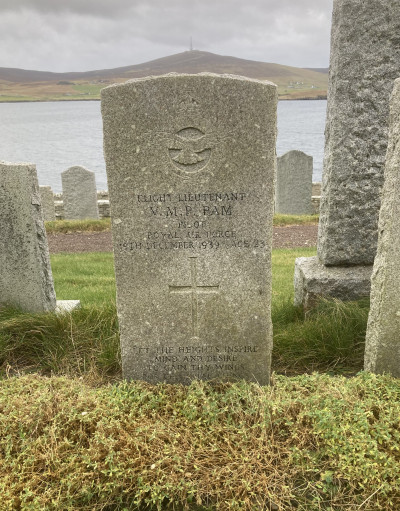
FLIGHT LIEUTENANT VINCENT MARK PAUL PAM
Text of gravestone: Flight Lieutenant / V.M.P. PAM / Pilot / Royal Air Force / 19th December 1939 Age 23 / + / Let the heights inspire / Mind and desire / To gain thy wings / For celestial things.
Vincent Pam was the pilot of a 240 Squadron Saro London flying boat operating out of Invergordon. He was patrolling waters east of Shetland on 19th December 1939 when, at about 10.30 in the morning, he encountered a German Heinkel 111 bomber. The two planes engaged in action and Vincent Pam was strafed with bullets across the chest. The second pilot, Pilot Officer Roger Hunter, managed to fly the plane back to Sullom Voe, where Vincent Pam was given emergency first aid. He died about 30 minutes after landing. The Heinkel crashed on its return to the Frisian Island of Stylt and was written off. [For a transcript of the 240 Squadron Operations Record Book and photo, allegedly showing the Heinkel 111 chasing Vincent Pam's Saro London, see Samuel Sjoberg's "Air Raid Islands" pp. 19-20.]

Extract from the Shetland News of 28 December 1939. Picture source: Shetland Archives.
There was no Catholic priest in Shetland at this time and the Brigadier had to wire for the Orkney priest to come up to conduct the funeral at St Margaret's. Fr Wilfrid Davis flew up and was brought to Lerwick in an open jeep through driving rain. Around April 1984, one of the parish sisters interviewed Miss Winnie Anderson who remembered the funeral. She said that Vincent Pam was a New Zealander and that his mother had come over to Britain to be with him while he was here. Winnie and her sister tidied and cleaned the church, and Dr Campbell's wife played soft music while the soldiers gathered for the funeral. The transcript of the interview is in the Shetland Archives (SA 3/2/91/1). We also have an account of the funeral from the Shetland News of 28 December 1939. About 150 officers and men attended the service, including units of the R.A.F. and the Army and Navy. That is almost the capacity of the church. The coffin was draped with the Union Jack, and the dead officer's cap lay on top of it. The body was conveyed to the Knab cemetery and buried near the First World War graves about three terraces up from the harbour, slightly apart from the main block of later WW2 graves in the cemetery. An R.A.F. firing party fired three rounds, the "Last Post" and "Rouse" were sounded, then pipers played the lament "The Flowers of the Forest". The priest flew back to Orkney the next day.
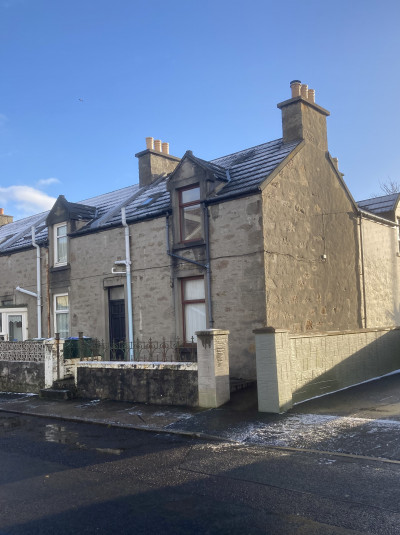
Wartime billet of Catholic Military Chaplains, 8 St Sunniva Street, Lerwick.
Within a week, on 1st January 1940, the first of the Army Chaplains arrived in Lerwick. He was Fr Kenneth Gillespie, O.F.M., a 39 year old Glaswegian who had joined the Franciscans in 1929 and had already done some military service in Orkney before coming to Shetland. (Most of his later ministry was in Wales and he built the Catholic churches in Llanidloes and Rhayader in the 1950s). He was billeted with the Anderson family in 8 St Sunniva Street. Their house backed on to Gilbertson Park, the town's sports ground, which had been repurposed as an army camp for the Black Watch. Winnie Anderson's father, by then in his eighties, realised that if they did not offer to take someone in, the house would be forcibly taken from them, and it became a tradition for the Catholic Padres to stay with the Andersons. Fr Gillespie probably stayed for less than one year since he was not in Shetland to celebrate Christmas in 1940; his next posting was in Orkney. Later military chaplains included Padre Oliver Patrick Conroy, CSsR, from the RAF (based at Sullom Voe and serving also Sumburgh), Padre Poltadiswiscz, and Padre William Hart (later Bishop of Dunkeld from 1955-81). Fr Hart was followed by Padre Hugh Gordon from Edinburgh. There was another military camp, the "Circus Camp" adjacent to the Catholic Church and stretching out to the tennis courts between King Harold Street and St Olaf Street. It housed a platoon of the Gordons and the Marines in a series of Nissan huts occupying the site of the present children's play park. Shetland was of great importance during the war because of its strategic position. Its role in the Norwegian Resistance movement (the "Shetland Bus") is still celebrated annually by both Shetlanders and Norwegians. The Free French were also here with their submarines. It is estimated that about 20,000 troops were stationed in Shetland during the war, effectively doubling the population of the islands.
SERGEANT RICHARD CHARLES DENLEY
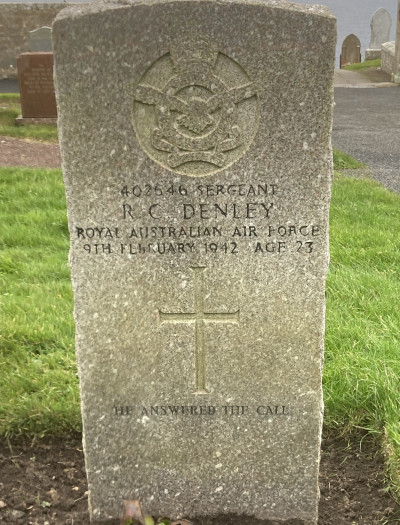
Text of gravestone: 402646 SERGEANT R.C. DENLEY / ROYAL AUSTRALIAN AIR FORCE / 9th FEBRUARY 1942, AGE 23 / + / HE ANSWERED THE CALL.
Sergeant Richard Denley was an Australian airman. He was killed in a training exercise when his Beaufighter crashed near Quendale. His funeral was held at St Margaret's Church on 13th February 1942.(Information source: Samuel Sjoberg).
FLIGHT SERGEANT JOHN P.B.R. BUCKLEY

Text of gravestone: R. 56144 FLIGHT SERGEANT J.P.B.R. BUCKLEY / WIRELESS OPERATOR/AIR GUNNER / ROYAL CANADIAN AIR FORCE / 31st MARCH 1942 / + /.
John Buckley was part of an audacious military operation to sink one of Hitler's most powerful warships, the "Tirpitz", when it was anchored in a Norwegian fjord. The story is told in Nigel Smith's book, "Tirpitz: The Halifax Raids", Air Research Publications, 1994 (especially pages 83-87). On 30th March 1942, a group of Halifax bombers had set off from Lossiemouth, Tain and Kinloss in the North East of Scotland, passing over Shetland on their way to Norway. The mission was a failure because of heavy cloud cover, the ineffective attack on the Tirpitz came just before midnight. The ship sustained little damage but many of the Halifax bombers were lost on the return journey. Flight Sergeant John Buckley was on a Halifax of 35 Squadron, flying out from Kinloss. In the early hours of 31st March 1942, the plane smashed into the cliff of Fitful Head, perhaps while attempting a landing at Sumburgh airbase in the fog. The cliff face rises almost 1,000 feet vertically from the sea at that point. Two bodies, those of John Buckley and Sergeant Usher, and some wreckage were found near the top of the cliff. A third body, that of Sergeant R. Meredith, was found further down the cliff face but could not be recovered. The other bodies were never found. A monument now stands at the crash site which lists the dead. It is located on Fitful head just to the south of the radar dome.
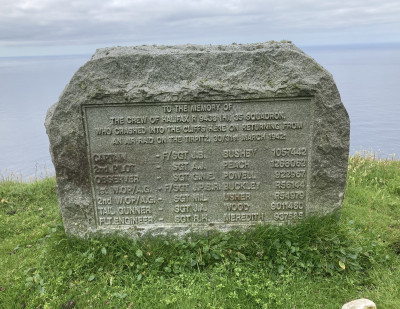
Flight Sergeant Buckley and Sergeant Usher are buried side by side in the Knab cemetery, near the grave of Sergeant Richard Denley. Perhaps there were other Catholic war dead but at present we have no record of them. John Buckley is also commemorated in a monument to Canadian servicemen in St Magnus Church in Lerwick, Scottish Episcopal Church.
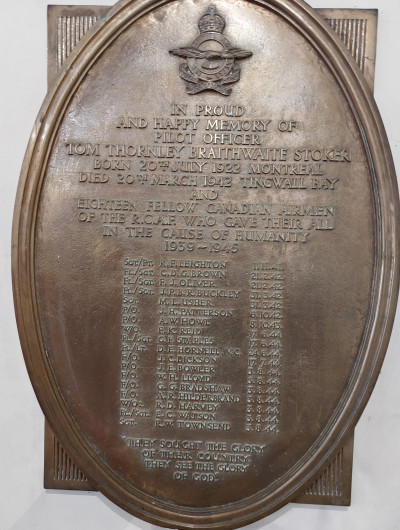
Samuel Sjoberg's researches have also unearthed a seasonal clipping from the Shetland News of 1st January 1942:
CATHOLIC CHURCH
For the first time for centuries in the Catholic Church in Shetland Mass was celebrated on Christmas Eve [24 December 1941]. Two Masses were said, one at the airport by Fr O.P. Conroy R.A.F., and the other in the chapel at Lerwick by Father Hugh Gordon, C.F. The chancel had been decorated with holly , etc., and the newly-installed electric light was used for the first time. The service, which was preceded by Christmas carols was very largely attended, mainly by men in uniform.
Fr Ambrose Flavell, 22 November 2024.
Dolly O'Reilly, RIP
9 Nov 2024
Willie Halcrow has drawn my attention to a death notice in this week's "Shetland Times" (8 November 2024).
O'REILLY - Dolly (nee Anderson). Wife of Peter and mother of Cathie, Jim, Barbara, Siobhan and Kevin. Died peacefully at Heath Lodge Care Home, Holt, Norfolk, on 21st October 2024, aged 90 years. Her laughter and love of life will be forever with us.

Dolly Anderson was one of our first parishioners when the Jesuits took on Shetland as a parish in 1954. Before that date, St Margaret's had been served on an occasional basis by the parish priest of Orkney. There were only 18 Catholics in Shetland in 1954 but the Jesuits sent two priests (Fr Joseph Whitaker, SJ, and Fr Frank Cairns, SJ) to develop the church here. Our parish registers begin at this point.
Dolly appears on the opening pages of our Baptism, Confirmation and Marriage registers. She was born on 20th July 1934, the daughter of Robert Andrew Anderson and Jessica (Jessie) Anderson, nee Nicholson. She was 19 when she received baptism at St Margaret's on 18th April 1954, presumably as an adult convert preparing for marriage. There is some confusion about her name, she is entered in the baptism register (second entry) as Joanna Maria Anderson but Fr Whitaker has placed in brackets "Dolly, Jessie". She was then living at 9 North Lochside Road, Lerwick.

The first picture shows Dolly Anderson being confirmed by Bishop Francis Walsh (Bishop of Aberdeen) on Sunday 27th June 1954. Fr Whitaker is assisting. This was the bishop's first visit to Shetland after the parish was assigned to the Jesuits. Her sponsor was Mrs Jessie Gray, the mother of the girl in the second picture, Isabel Gray. Dolly appears more clearly in this picture as sponsor to Isabel, having just been confirmed herself a few minutes before. The main altar is still recognizable although of course the sanctuary was remodelled in the 1960s and a new altar brought forward. Dolly appears in the Confirmation Register (1st entry) as "Joanna (Jessie) Maria Anderson. She took St Colette as her confirmation patron.
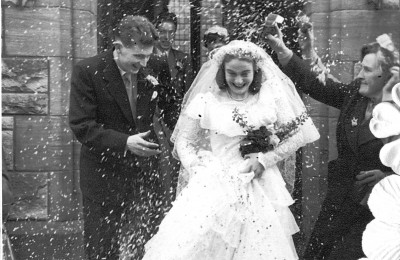
Within three months Dolly was back at St Margaret's for her wedding. She married Peter Reilly on the 23rd September 1954. In her entry in the Marriage Register (Number 3) her name is given as Jessie ("Dolly") Anderson. She was 20 years of age and looks radiantly happy in this picture as she leaves the church after the wedding. Peter was four years her senior. He was born in Surrey and had served with the RAF in Northern Ireland before moving to Lerwick near the beginning of 1952 as a meteorologist. He lived at the Observatory. This photo has a special interest for us at the moment since it looks through to one of the four windows on the south wall of the church and confirms that the original glass from the 1911 building was in square panes. We are currently raising funds to replace the diamond pane windows which were substituted for the original glass. The most likely date for the replacement was between this photo in 1954 and the redecoration and re-dedication of the church in 1958, after the Jesuits took responsibility for the parish.
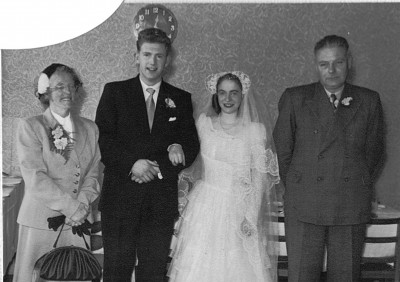
The wedding reception was at The Excelsior, upstairs. From left to right: Mrs Anderson, Peter Reilly, Dolly and Provost Anderson. We still have Fr Whitaker's notes for the wedding in the archive. The couple moved south but kept contact with the parish. The photographs used in this blog are from the albums prepared for the Centenary of St Margaret's Church in 2011. A note from that date states: "Peter has since died but Dolly remains a regular visitor to Shetland as she still has family here, and told us of the many delightful evenings she and Peter would spend with the two priests playing bridge. Fr Whitaker took this all rather seriously and apparently would get very annoyed if the play wasn't of the highest standard! Dolly also remembers playing 'a strange little pedal organ' and says that some of the notes were a bit wayward."
May she rest in peace!
North Pole Mission, 1855-1869, Places
4 Jul 2024
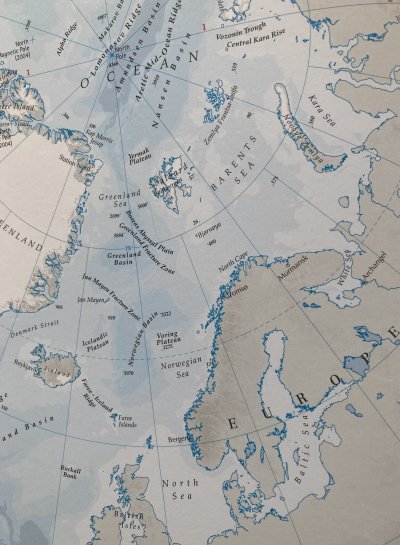
ARCTIC NORWAY – FAROES – ORKNEY AND SHETLAND – CAITHNESS – ICELAND
The headquarters of the North Pole Mission were in Alta (Norway) 1855-1860; Wick (Scotland) 1860-1866; Copenhagen (Denmark) 1866-1869.
The NORTH POLE MISSION was established by Pope Pius IX on 8th December 1855, the first anniversary of the proclamation of the doctrine of the Immaculate Conception. It was placed under the jurisdiction of Propaganda Fidei in Rome.
The original intention appears to have been a mission to all lands north of 64 degrees latitude in the Arctic Circle. It was to be an international Prefecture Apostolic with its base at Alta on the north Norwegian Coast. The founding missionaries had hoped to expand westwards to Greenland and Hudson Bay in North America but resources were always sparse and the North Pole Mission was confined to Arctic Norway (1855), Iceland (1857), the Faroe Islands (1857) and Orkney, Shetland and Caithness in Northern Scotland (1860).
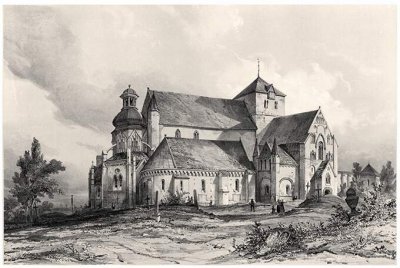
The choice of mission stations was partly guided by practical concerns, partly by a desire to reflect the territory of the medieval Norwegian diocese of NIDAROS (modern Trondheim). The medieval see of Nidaros, according to a twelfth century document, had metropolitan jurisdiction over the Norwegian churches of Nidaros, Bergen, Stavanger, Oslo and Hamar. The bishop’s authority also extended to Norwegian territories overseas: Orkney and Shetland; the Western Isles and the Isle of Man; the Faroes; Holar (Iceland), Skalholt (Iceland); and Gandar (Greenland).
The North Pole Mission comprised six principal stations, served by eight priests, listed in 1865 as follows: 1. Altengaard, Norway; 2. Tromso, Norway; 3. Thorshavn, Faroe Islands; 4. Reykjavik, Iceland; 5. Shetland, Orkney and Caithness, Scotland; 6. Lerwick, Shetland Islands.
THE MISSION TO ARCTIC NORWAY (1856-1869)
Norway had become at least nominally Christian in the reign of King Olaf Tryggvason in the late 10th Century and had belonged to the Catholic Church until the 16th Century Protestant Reformation. From that date on the country was Lutheran.
On 16th July 1845, the King of Norway-Denmark for the first time permitted religious dissenters and other churches could move into his kingdom. Toleration did not extend to Jews, Jesuits, or orders of monks.
Eleven years after this royal decree, Etienne Djunkowsky, Prefect Apostolic of the newly created North Pole Mission established his base at the fishing village of Alta (70 degrees north). It was near the Russian border and, despite its remote location well within the Arctic Circle, many ships passed through. Djunkowsky reported to the Roman authorities at Propaganda Fidei that every year 800 Russian vessels arrived at the port, representing 7,000 -10,000 men putting in for commerce. The Lapland mission had potential for access to the Russian empire.
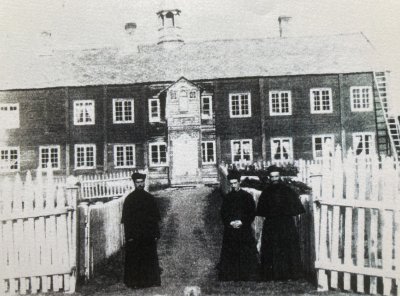
On 29th July 1856, Djunkowsky established a missionary college at Alta, also known as Altengaard. He had purchased a magnificent estate which had previously been the residence of the Governor General of Lapland. The house had a beautiful setting, with fields and meadows, cattle and timber, in striking contrast to the surrounding area, and the area enjoyed a mild climate. The chapel was in a room on the first floor and the missionaries also had a library of several hundred volumes. The purchase was achieved with the support of Belgian benefactors. The photograph was taken in the 1880s but shows the building adapted as the first mission headquarters, seminary and residence. There were at least four missionaries present here in 1856: the Apostolic Prefect, Etienne Djunkowsky; his Vicar General, Abbé Bernard Bernard, Fr Georg Bauer and the Icelandic layman, Dr Ólafur Gunlögssen.
By 1859 there was a mission at Tromso, the capital of Norwegian Lapland. Djunkowsky intended this to be the centre for the arctic mission since steamships put in at the port and there was easy communication with Iceland and the Faroes. The Gothic-style chapel in Tromso was built in 1860 in the countryside just outside the town, there was also a Catholic cemetery. This was the most successful of the Lapland missions in terms of conversions. It had gone in a short time from being a town with no Catholics to a fair sized parish.
From Tromso the mission was also extended to the only other substantial town in Lapland, Hammerfest. Here there was only a house and land set aside for a future church. Abbé Boller was described as the superior of the Lapland Mission in 1859, when there were five stations: in addition to the three already mentioned, he had charge of Vina in the mountains of Lapland and Gjesvar, situated near North Cape, beyond which there was no habitation. An additional station at Namsen was confided to the North Pole Mission, before October 1860, by Mgr. Studach, Vicar Apostolic of Sweden and Norway.
After the ending of the North Pole Mission in 1869, Monsignor Bernard Bernard became the Apostolic Prefect of a newly defined Norwegian prefecture. In 1876 he approached the Missionaries of Our Lady of La Salette, then still a strictly diocesan congregation in the diocese of Grenoble, to provide clergy for Norway. After some initial hesitation, they agreed and on 6th March 1879 the Sacred Congregation for the Propagation of the Faith confided the Norwegian Mission to the Missionaries of Our Lady of La Salette for a trial period of ten years. They withdrew from Norway in 1892.
THE MISSION TO ICELAND (1857-75).
Djunkowsky sent Abbé Bernard Bernard to Iceland in 1856. Djunkowsky arrived in 1857 to establish the mission and the following spring Fr. Jean-Baptist Baudoin was sent as assistant priest. Bernard Bernard is listed in 1859 as Superior in Iceland. There were anti-Catholic laws in place in Iceland and the missionaries were only allowed to serve the pastoral needs of Catholic fishermen and whalers, mainly from France and Belgium. Between 240 and 300 boats put in to Iceland ports. At the beginning they were very short of resources and the two priests had to share a single room, rented from a Danish merchant, where they also celebrated Mass. This lack of space made it very difficult for the missionaries to gather the people for instruction in the faith. Soon after arrival in Iceland, Bernard made a reconnaissance journey to the north of the country.
The first base was at Seydisfjordur on the east coast. Bernard rented a room where the French and Belgian fishermen could worship. In 1859 he moved the mission to Grundarfjordur and then, in 1860, to Reykjavik where he bought a property at Landakot. He built a modest wooden chapel here in 1864.
The Icelandic authorities blocked Abbé Bernard’s attempts to establish a school and hospital in Reykjavik and these were not finally built until the 20th century, although in July 1859 the missionaries received permission to open a hospital in Seydisfjordur for the benefit of Catholic fishermen. The Icelandic mission did not take root. Bernard left Iceland in 1862, and was replaced by E.M. Dekiere in 1864 who worked in Iceland until his transfer to Norway in 1867. Baudouin persevered until 1875.
THE MISSION TO THE FAROE ISLANDS (1858-72)
Like Norway, the Faroes had been closed to Catholic missions before the royal decree of 1845. The first missionary here was the German priest Georg Bauer. He initially met with hostility and suspicion. Bauer arrived from Norway in 1857 with an Italian assistant-priest, Luigi Mossa, who does not appear to have stayed long. The Faroes were then served by steam ships twice a month between March and November, linking the islands to Scotland, Denmark and Iceland. At the end of 1858 Bauer was joined by a young newly-ordained priest from Belgium, Theophilus Verstraeten, who was transferred to Shetland in October 1860. A house was purchased this year at Raettara in the capital Thorshavn and a church was opened in July 1859. Seventy people participated in the first Mass there. The congregation was mainly made up of Belgian and French fishermen. Fr Bauer remained twelve years in the Faroes until 1872. For much of the time he was the sole priest in the islands and, if the Prefect Apostolic did not make a visit, needed to travel to Scotland at least once a year for confession. The mission was abandoned in 1894.
MISSION TO ORKNEY, SHETLAND AND CAITHNESS (1860-69)
Orkney and Shetland had belonged to Norway from the late 10th to mid 15th centuries. Their addition to the North Pole Mission came in 1860 after discussions with Cardinal Wiseman in London and bishops Gillis and Kyle in Scotland. Djunkowsky had realised the impracticality of Alta as the centre of the mission given that it was at the far extremity of the territory assigned him. In 1858, when negotiations to transfer the mission headquarters to Copenhagen had stalled, Djunkowsky proposed Kirkwall in Orkney as “equidistant from Rome, Iceland and Altengaard”.
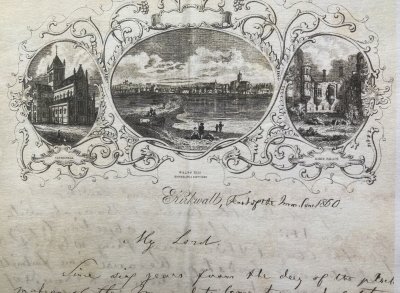
Letter of Djunkowsky to Bishop Kyle 08.12.1860 mentioning the acquisition of Orkney and Shetland. The letter heading shows the medieval Cathedral of Kirkwall and the ruined Bishop’s Palace, near which Djunkowsky had obtained lodgings.
In the end, Wick in Caithness was chosen as being a flourishing fishing port, frequented by Scandinavian fishermen. The three territories of Orkney, Shetland and Caithness were detached from the Northern District of the Scottish church and assigned to Djunkowsky as part of the North Pole Mission. This arrangement remained in place until 1869 when the North Pole Mission was broken up into national territories. The headquarters of the Mission was transferred to Copenhagen in Denmark in 1866. The chapel of St Joachim and presbytery had already been established in Wick, and were entrusted to the Mission for its use. A little before 1869, the missionaries had built a house at Wick which was intended as a school, which was to be run by religious sisters of the Faithful Companions of Jesus. The railway had not yet been constructed and transport was provided by a steamer which ran once a week in winter, and twice a week in the summer.
Djunkowsky arrived in Lerwick by sea on 30th September 1860 and established his base at the Zetland Hotel. Fr Theophilus Verstraeten was summoned to Lerwick from the Faroes to take charge of the new mission in Shetland and he would remain here – apart from short periods assisting in Orkney and Caithness – until his premature death, eleven years later, on 30th May 1871.
The first chapel in Lerwick was established in a warehouse (Clark's Lodberry) reached from Sinclair's Beach. In 1864 Fr Theophilus Verstraeten bought the Zetland Hotel building and Mass was said in an upstairs room, accessed from Queen's Lane. Shortly before his death, Fr Verstaeten had drawn up plans for a more permanent chapel in the garden of the Zetland Hotel building (77 Commercial Street) but the work was abandoned when Shetland no longer had a resident priest and the building sold.
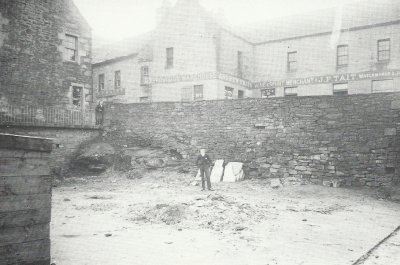
The Zetland Hotel building in 1904, taken from Sinclair's beach. The entrance to the original chapel of St Anne was just out of shot. It was reached from the beach. Fr Theophilus Verstraeten had lodgings with the Clark family 1860-64 in the building on the left of the photograph (40 & 42 Commercial Street).
Orkney had no resident priest and was served at intervals from Wick. The Prefect Apostolic, Bernard Bernard, was the sole priest in Wick, and Caithness was left without pastoral provision when Bernard was visiting the other stations of the Mission. When Bernard moved the mission headquarters to Copenhagen in 1866, he appointed J.P. Capron to Wick. Capron was later assisted by Claude Dumahut and Rev Vanwtberghe from Bruges.
COPENHAGEN, Denmark.
In 1866, Copenhagen was made the administrative centre of the North Pole Mission because of its transport links to the Faroes, Iceland and Norway. It had previously been based in Wick, Scotland. The transfer of the Prefect Apostolic to Copenhagen was approved by Propaganda Fidei at its meeting of 20th March 1866. The mission acquired a house in the Nörrebro district of Copenhagen as residence of the Prefect Apostolic, still only half paid-for in 1869, and there were plans to establish a seminary in the city. It was described in 1869 as “la Solitude”.
THE SUBSEQUENT HISTORY OF THE MISSION TERRITORIES.
After the dismantling of the North Pole Mission in 1869 the Norwegian Arctic Missions became part of the new Prefecture Apostolic of Norway.
Denmark was also established as a Prefecture Apostolic, overseeing the missions in Iceland and the Faroes.
The missions of Caithness, Orkney and Shetland were returned to the Vicar Apostolic of the Northern District of Scotland. In 1878 the hierarchy was restored and these territories became part of the Roman Catholic Diocese of Aberdeen.
North Pole Mission Clergy
25 Apr 2024
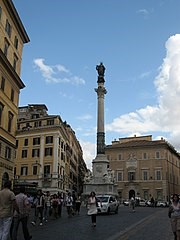
Etienne Djunkowsky, founder of the North Pole Mission, dates its inception to 8th December 1854, the day Pope Pius IX proclaimed the dogma of the Immaculate Conception of the Blessed Virgin Mary in a solemn celebration in Rome which Djunkowski had witnessed. He had been inspired with the idea of a new mission to the extreme limits of the arctic circle, areas which had been evangelised a thousand years before but which had been lost to the Catholic Church in the three hundred years since the Protestant Reformation. Most of these lands were now Lutheran. Djunkowsky sought the approval of Pope Pius IX and was given encouragement to proceed. After a successful preliminary exploration in these northern lands, Pope Pius IX erected the Prefecture Apostolic of the North Pole which was placed under the special protection of the Sacred Heart of Jesus and the patronage of the Immaculate Conception of the Blessed Virgin Mary. This vast prefecture embraced the territories of six medieval Catholic dioceses and parts of arctic North America which had been more recently discovered and were inhabited by nomadic eskimos. Etienne Djunkowsky was nominated as the first Apostolic Prefect.
The first six missionaries were recruited in 1856, four of them were priests. On 4th August 1858, meeting at Malines, the bishops of Belgium, took a special interest in the North Pole Mission and encouraged the faithful of their dioceses (Malines, Tournai, Namur, Ghent, Bruges and Liége) to support it financially, setting up an association of the faithful with a subscription of one Franc a year for ten years. The Belgian bishops also asked the faithful to pray for the success of the mission and committed themselves to support the North Pole Mission for ten years (1858-1868). The Rev. X. Ciamberlani, of Beveren, near Antwerp, was appointed Procurator of the North Pole Mission, and M. De Pauw, lecturer at the Major Seminary at Malines, was made Treasurer General for the Work of the Mission in the archdiocese. The collection of funds was intended to supplement the aid already given by the Roman Congregation for the Propagation of the Faith.
The mission report of 1862, after Djunkowsky had resigned as Prefect Apostolic, lists eight priests in the order in which they had joined the North Pole Mission.
1. Very Rev Bernard Bernard, from the diocese of Rheims, Prefect Apostolic.
2. Rev G. Bauer, from the diocese of Ratisbon.
3. Rev A. Boller, from the diocese of Würzburg.
4. Rev A. Baudoin, from the diocese of Rheims.
5. Rev E. Maesfrancx, from the diocese of Ghent.
6. Rev Th. Verstraeten, from the diocese of Ghent.
7. Rev S. Moriga, from the diocese of Rome.
8. Rev J.M. Convers, from the diocese of Lyons.
Two other priests were due to join the mission in the near future.
In the 1865 report, Bernard says there were eight priests on the Mission, not including Rev S. Moriga who had returned to Italy in 1863. The Mission had in the first eight years of its existence lost more members than it currently numbered, only one of the losses was caused by death. Bernard blamed the extreme climate and the difficulties of the Mission. In 1865 the following priests were working on the North Pole Mission:
1. Very Rev Bernard Bernard, Prefect Apostolic, provisionally resident in Wick, Scotland.
2. Rev And. Boller, resident at Tromso, Norway. (Lapland mission).
3. Rev E. Maesfrancx, resident at Altengaard, Norway. (Lapland mission).
4. Rev G. Bauer, resident at Thorshaven, Faroe Islands.
5. Rev J.M. Convers, resident at Thorshaven, Faroe Islands.
6. Rev J.B. Baudoin, resident at Reykjavik, Iceland.
7. Rev E.M. Dekiere, resident at Reykjavic, Iceland.
8. Rev Th. Verstraeten, resident at Lerwick, Shetland Islands.
In 1865 there were also six seminarians for the Missions, studying in various seminaries.
In 1869 there were 13 priests working on the Mission and ten students, of whom two were due to be ordained in the summer of 1870. The nationality of the priests was: five Belgians (Rev Maesfrancx was at this point on leave of absence, but still attached to the North Pole Mission), two Bavarians and six French. The students included seven indigenous children.
Missionaries of the North Pole Mission.
PAUL MARIE ETIENNE de DJUNKOWSKY (1821-1870). He used the French form of his name (often Père Etienne) but in his native Russian was (Baron) Stepan Stepanovich Djunkowsky. His mother was from the Netherlands. Born near St Petersburg on 22nd February 1821, and so only 39 years old when he first came to Shetland. He was one of a group of Russian aristocrats in the circle of Prince Ivan Gagarin who were working to achieve unification between the Russian Orthodox and Catholic churches. They had all forfeited their lands by becoming Catholic and would have faced exile in Siberia if they had returned. In 1845, at the age of 24, Djunkowsky had joined Prince Gagarin in the Jesuit novitiate in France but left the order before ordination. He was ordained in Paris as a secular priest in 1852. Djunkowsky went to Rome in 1854 for the proclamation of the Dogma of the Immaculate Conception and was there recruited as the Prefect Apostolic (equivalent in authority to a bishop, but without the power to ordain priests) of the new North Pole Mission. Within months he had moved to Arctic Norway. We have no photographs of him but a contemporary account describes him as a stocky man, with a “barbarian” look, deep-set eyes, wide nostrils, large mouth and prominent cheek bones. He impressed acquaintances by his gift for languages (he spoke at least five), and his connections with Pope Pius IX and the Académie Française. In Belgium Djunkowsky established a base in Antwerp (c.1857-59) and was housed and supported by the Antwerp sugar magnate J. Dewyndt-Aerts. Djunkowsky has the distinction of having said the first post-Reformation Mass in Shetland (October 1860) but spent only a couple of weeks in the islands before returning to Orkney and Wick. Djunkowsky suffered a breakdown in health and abruptly left the North Pole Mission in September 1861. He was briefly excommunicated by Rome after marrying an Anglican Englishwoman but the marriage did not last and he was reconciled with the church. He lived in Germany for a while, engaged in literary projects, but reconverted to Russian Orthodoxy in order to recover his estates in Russia. He died there, aged 49, on 25th March 1870.

ABBE BERNARD BERNARD (1821-1895). Born in France 21st July 1821 in Mogues. Studied in Rome and was ordained priest in Rheims by Archbishop Thomas-Marie-Joseph Gousset on 5th July 1846. He joined the North Pole Mission at the suggestion of his bishop, who had a great respect for Djunkowsky. He had previously been a diocesan priest for a number of years in the Ardennes. Bernard was present at the opening of the Alta Mission, Norway, in 1856, but that same year was sent by Djunkowsky to Iceland to start the mission station there. He returned to France in 1858-59 on a fundraising appeal and was at that date described by Djunkowsky as his Vicar General. He arrived in Lerwick with Fr Theophilus Verstraeten on 7th October 1860 and received Mary Nicolson into the Catholic Church after Djunkowsky’s departure for Orkney. When Djunkowsky left the mission in October 1861, Bernard was appointed Prefect Apostolic and took up residence in Wick. In 1866 he transferred the headquarters of his mission to Copenhagen. Three years later the North Pole Mission was dissolved and Bernard was appointed Prefect Apostolic of Norway and Lapland with residence in Trondheim. While in Norway he joined the missionary order of Our Lady of La Salette, an order whose priests were assisting him in Norway, and when he resigned as Prefect Apostolic in 1887, he returned to France. His congregation assigned him to the Shrine of Notre Dame de l’Hermitage, near Noirétable (about 100 km west of Lyon) and he died there on 28th October 1895 at the age of 74. He was just a few months short of his Golden Jubilee of ordination. He is buried at the shrine. Like Djunkowsky, he was 39 when he first arrived in Shetland in 1860.
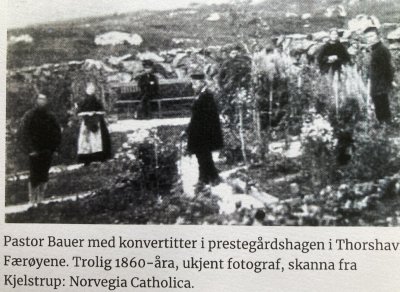
GEORG BAUER was a Bavarian priest from the diocese of Ratisbon. Bauer was with Djunkowsky at Alta in Norway at the beginning of the mission and from there was sent to Torshavn in the Faroe Islands in 1857. He was accompanied by an Italian priest, Luigi Mussa, who is not otherwise mentioned. At the time of Verstraeten’s arrival in 1859, he had been alone on the mission for more than a year. Bauer left the Faroes in 1872. In 1869 he was described by Bernard as the vice-Prefect of the North Pole Mission.
A. BOLLER was a Bavarian priest from the diocese of Wurzburg. Described as superior of the Lapland mission in 1859 and listed in the 1865 Scottish Catholic Directory as still resident in Tromso, Norway.
(A. in the 1862 list) JEAN-BAPTIST BAUDOIN (1831-1875). French, from the diocese of Rheims. Sent by Djunkowsky to Iceland in the spring of 1858. Assisted at first by Bernard Bernard, he was the first Catholic priest to minister in Iceland since the Reformation. Bernard left in 1862 but Baudoin persevered in the Iceland mission until 1875.
ELIAS MAESFRANCX (1819-1892). Belgian, from the diocese of Ghent. His brother was in 1859 parish priest of Peteghem-Deynze, near Ghent. Maesfrancx arrived in Lapland before October 1859 and was listed as Apostolic Missioner and Parish Priest in Alten-Talvig in Lapland, Norway, in June 1860. Still resident at Altengaard in 1865. He moved to Trondheim in 1866 and then travelled to the United States. Bernard announced in the 1869 report that Maesfrancx was taking some leave of absence because his health could no longer cope with the hard climate of Lapland, but he remained attached to the North Pole Mission and would seek occasion to return. From 1870-72 he was again in Trondheim, then returned to Belgium. In 1875 he moved to Detroit diocese, Michigan, in the United States and served in St Mary’s Church, New Baltimore, and St Charles’ Church, Newport until at least 1879. He returned to Europe and was living in retirement in Lourdes but died in Belgium in 1892.
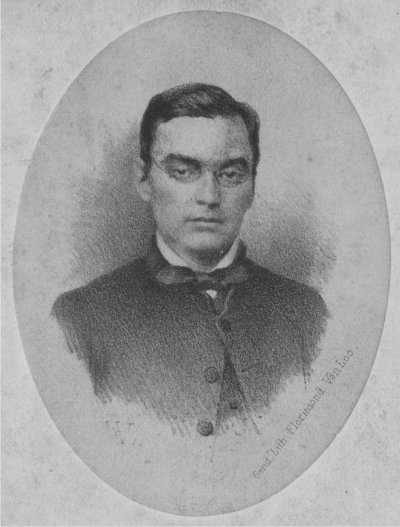
THEOPHILUS MARIE VERSTRAETEN (1832-1871). Belgian, from the diocese of Ghent. Born in Bottelare, 27th December 1832. Ordained in Ghent 18th December 1858. He was recruited to the North Pole Mission while still a seminarian and seven months after ordination he was sent to assist Fr Bauer in the Faroe Islands (14th July 1859). With his arrival, donations from Belgium in support of the mission doubled from two years before in 1857. Fr Verstraeten spoke no German and was still very imperfect in Danish, so he and Bauer had to communicate in Latin. From the Faroes he was summoned to take over the new Mission to Shetland (7th October 1860) and remained as resident priest in Lerwick for eleven years until his death on 30th May 1871. He assisted elsewhere in Northern Scotland and in the Wick register described himself as “the missionary in Caithness, Orkney and Shetland”. He was buried in Bottelare on 9th June 1871. Fr Verstraeten was 27 when he came to Shetland and 38 when he died.
S. MORIGA. From the diocese of Rome. He left the North Pole Mission in April 1863 on medical advice, because of the effect of the climate on his health and returned to Italy.
LUIGI MUSSA. Italian. Accompanied Georg Bauer to the Faroe Islands in 1857 but left soon after.
P. BIANCHINI. Missionary priest stationed at Olafshaven (Altengaard) in 1859. Left the mission before 1862.
J.M. CONVERS, French, from the diocese of Lyons. Arrived in the Faroes in 1862 or 1863. He was in residence by 18th April 1863. Listed in 1865 Scottish Catholic Directory as assisting Georg Bauer at Torshavn in the Faroes.
EMILE MARIE DEKIERE. Belgian, from Roeselare. Joined the Mission between 1862 and 1865. Listed in the 1865 Scottish Catholic Directory as assisting J.B. Baudoin at Reykjavik in Iceland. Had been a student of Guido Gezelle’s at Roeselare seminary and been encouraged to join the North Pole Mission by him. He worked first in Iceland, from where he kept up a correspondence with Gezelle for a while. He published a volume of Apologetics in Iceland in 1865. From 1867-1874 he worked in Norway and in 1869 he was assisting the Prefect Apostolic in setting up a new house in Copenhagen.
J.P. CAPRON, appointed to Wick as Apostolic Missioner by Bernard in 1866 after the headquarters of the Prefect Apostolic was moved to Copenhagen. He had previously been working in Lancashire among the poor. In 1867 he was assisting Claude Dumahut in Wick and attending the Orkney Islands, which were without a resident priest. Still resident in Wick (serving Orkney three times a year) in 1872.
Rev VANWTBERGHE. Belgian, from the diocese of Bruges. Described as a “young missionary” in 1869. Based in Wick, serving also he Orkney islands periodically.
HENRICK BLANCKE. Belgian. He had passed through Roeselare seminary and been recruited for the North Pole Mission there. Blancke is remembered as a slightly eccentric man. He worked from 1868-1870 in the Faroes, then from 1870 – 1887 in Norway. His main work in Norway was the mission station of Halden (Fredrikshald), which he founded.
CLAUDE DUMAHUT, born in France. Listed in 1867 as missionary with Capron in Wick. In 1872 he moved to Norway and became the first pastor of the Catholic Church in Trondheim.
- - - - -DR OLAFUR GUNLOGSSEN was the only Scandinavian member of the mission and a convert to Catholicism from Lutheranism. He was an Icelandic layman who had studied for a doctorate at the Catholic University of Louvain. He was with Djunkowsky when he made his first journey to Arctic Norway in the Spring of 1856 and established himself at the Alta mission. His special contribution was to translate medieval Scandinavian literature to raise awareness of the Catholic heritage of the Nordic lands. His translation of a poem in honour of the Blessed Virgin Mary went through two editions in three months, the first published in Copenhagen, the second in Vienna. He accompanied Djunkowsky on his visits to the Faroes in July 1860, to London the following month and then to Shetland in September. He stayed on briefly in Lerwick after Djunkowsky sailed for Orkney and was present with Bernard at the reception of Mary Nicolson into the Catholic Church in October 1860. Soon after this he left the North Pole Mission. Djunkowsky gave him a letter of introduction to Cardinal Wiseman in London with the hope that he would find employment in a college or with a family. Gunlögssen had been considering ordination to the priesthood but from November 1860 pursued a secular career.
Cammino dei Cappuccini
30 Sep 2023
In September 2023 a group of four Shetland parishioners walked 130 miles of the Cammino dei Cappuccini from Fossombrone to Camerino. Neil Work tells the story.
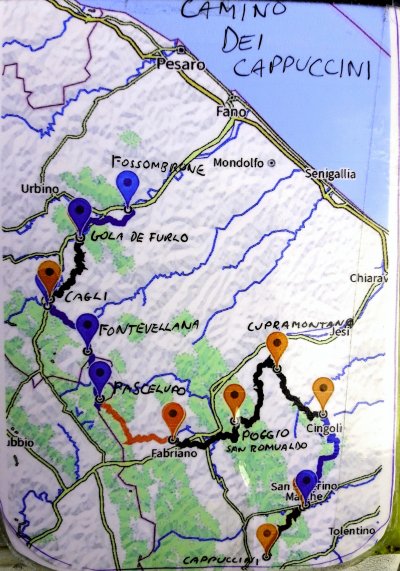
To celebrate five hundred years since their founding and to promote and hopefully attract men to their order, the Capuchin order have marked out a new camino pilgrim path. It runs North to South across the forested Apennine hills in central Italy, inland from Ancona. It attempts to follow the story of its founding and its links with earlier monastic history. To walk half its length over eleven days was the proposition for our 2023 Parish Pilgrimage. Lured by promises of 'pleasantly warm' weather a group of us signed up.
As John Bunyan's Christian got off to a shakey start, so did we. Our party was attacked by the giants of "B.A.", "Delay", "Cancellation", "Vouchers" & "Shuttle" while avoiding the temptations of "Vanity Fayre" in various European airports.
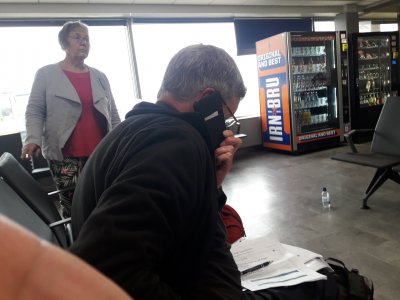
Meanwhile our solitary bus traveller had to contend with the giant "German" sitting next to him. Meeting up with him and tour rep Emmanuel we were driven across the mountainous spine of Italy to Fossombrone Capuchin friary, Fr. Ambrose battling the giant of "Double-Rooms-Instead-Of-Single-(Like-What-We-Paid-For)" to the bitter end. With success!
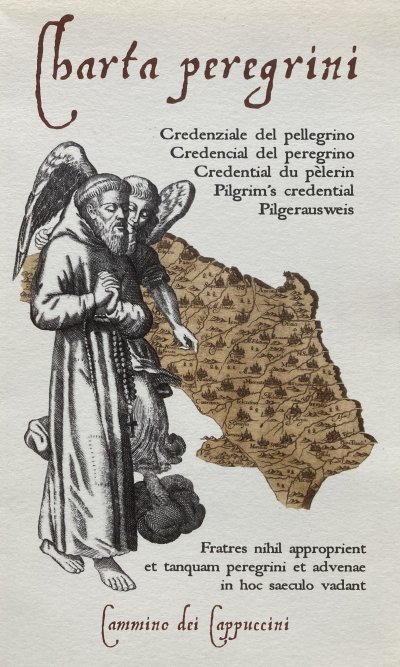
Issued with pilgrim pendants,credential cards to be stamped and given a blessing by brother Filippo, we set off next day into the Delectable Mountains with our Shepherd. Chastened a bit however by the comment from a daughter that our proud 'team starting' picture resembled an O.A.P. outing photo!
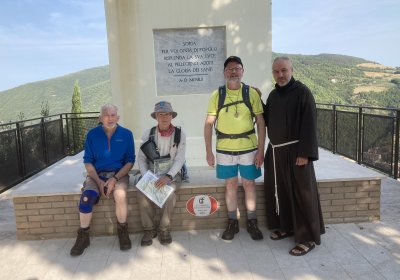
True,we all had various age related health issues, injuries and post op weaknesses to nurse. Youth, in the form of Fr. Ambrose dressed in Lincoln green forged ahead. Age, in my form and short legs, lagged last. Strangely the one who at the start of our pilgrimage constantly groaned " oo noo ! Uphill agin !" , by the end (according to Pete) was a machine who just needed to be switched on to disappear ahead dressed in the Albion Rovers shirt of the day. We soon found that the steep downhill segments were the most challenging- the limestone lumps acting like marbles underfoot, as the pale rock radiated the glaring heat.
Locals assured us that the oven like blast we Northerners were enduring was actually pleasantly cool compared to what they themselves had endured barely a week before, with temperatures way up in the 30's. No wonder they have siestas. Our feet swelled, toes blistered and compeed supplies dwindled, but the scenery delivered.
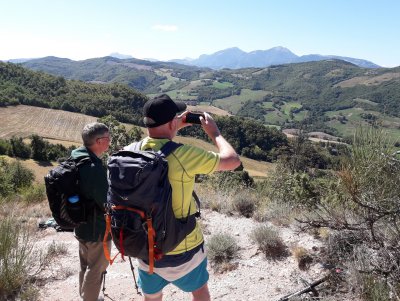
To me , it all seemed like the background to a Renaissance painting. The strange dreamlike fields with random trees, the towns with towers on hilltops, were all there when we reached vantage points. Then into the cooler forests and their green tunnels, the scenery more wooded and mountainous day by day as we went into the Marche national park, bathed in sweat.
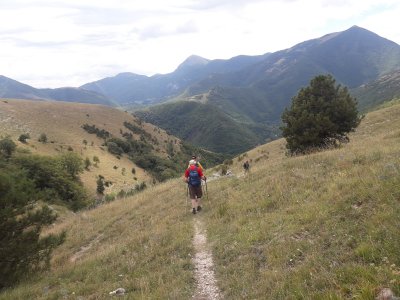
Following the approximate path of the Capuchin founders Fra Ludovico & Fra Raffaele, who were on the run from their more worldly superiors, in a few days we came to the magnificent monastery of Fonte Avellana. First built over a thousand years ago, I was astonished at the skill that went into the masonry of the 'scriptorium', where monks needed maximum light to copy scripture.
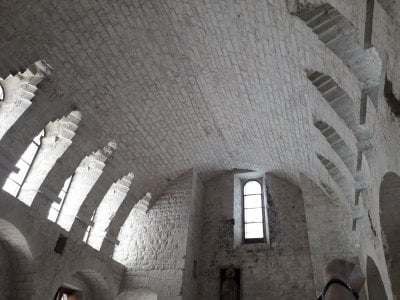
After Mass in the monastery chapel on our day off , we dined in the big refectory along with a large noisy crowd of faithful from the surrounding area, amused to find that the much vaunted "Mediterranean Diet" the NHS says we should follow is completely ignored in Italy. We even got free cake handed out at one point on the trail, when begging for water.
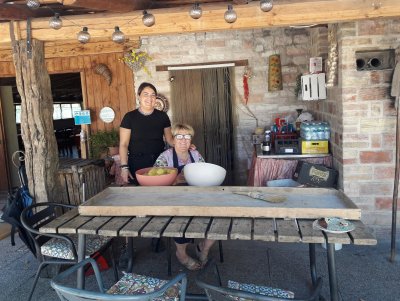
Our friendliest welcome was in the lovely mountain village of Pascelupo. Fr. Ambrose extended his tiring day by hiking up towards Blessed Paul Giustiniani's hermitage of San Girolamo, nestled high up in the forested slopes. We all regretted not joining him for various reasons. There are three brothers there, very strictly enclosed in solitary prayer, whose abbot comes down to the village occasionally to organise supplies.
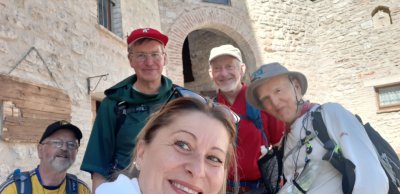
In Fabriano Pete stocked up for us with a tray of many butter sachets from a supermarket. The inability of Italians to make edible, lubricated panini rolls is a national disgrace, along with their inability to make a proper cup of tea without careful instruction. Without lemon.
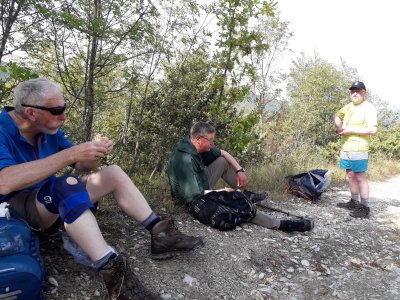
The greatest Delectable Mountain was given a "pass" by half of us - what a view they missed! - and we left the mountains for ripe vineyards and towns silhouetted on hills. We finally found the site where Blessed Paul Giustiniani met the friars on the run, and crucially encouraged them to found their order. In San Severino we stayed at a spotless convent where I was struck how kind the sisters were to their Alzheimer's sufferer.

Before heading to our goal at Camerino our final bidding prayer at Mass was composed to ask for a cool day and a level path. For the good of our souls the next day we endured a 3° rise in temperature , a huge open hill, and our composer got lost and had to walk back up a very steep hot tarmac road.
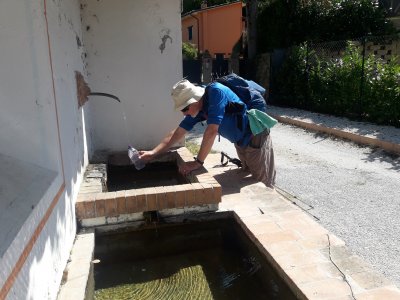
The spiced 'rosso' wine at the Capuchin friary of Renacavata was just amazing, as we tried to converse with the bearded brothers using translation apps, before turning in to get mosquitoed.
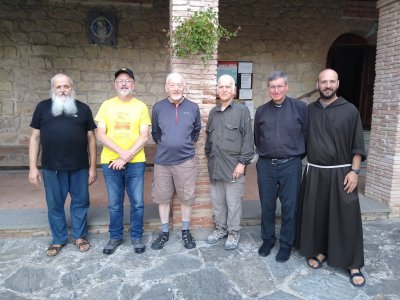

The final days ended as we began, fighting the giants of transport, until we could step out at last and get a lungful of cool Shetland air and feel the delicious sea breezes.
Bottelare to Lerwick and back ...
28 Sep 2023
We have launched an appeal to construct a monument to Fr Theophilus Verstraeten, first resident Catholic priest in Lerwick after the reformation (1860-71), in Bottelare. Hilde Bardell here tells the story of how ties were established with his home parish in Belgium.
Timeline: 2011

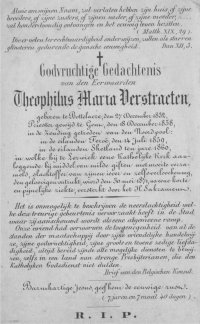
Pieter De Clercq finds an obituary card for Fr Theophilus Verstraeten in his mother's papers. No one knows who he is, so Pieter does an internet search and finds St Margaret's parish in Shetland is honouring him as part of their centenary celebrations. He gets in touch and information is shared, connections made.
2019
Shetland parishioner Hilde Bardell, Belgian by birth, meets up with Pieter De Clercq, visits Bottelare and St Anne's Church where Fr Theophilus was buried. Finds his grave is no longer there, but leaves a message in the intentions book about the Shetland connection, leaving an email address.
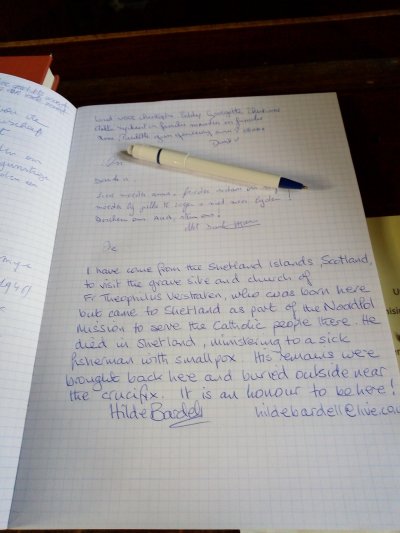
2020
Lieve Orye sees the message and emails Hilde. She finds that no one in Bottelare knows anything about Fr Theophilus, not even the parish archivist, so information is passed to and fro, resulting in Lieve writing three articles about the Lerwick-Bottelare connection for the local church magazines.
first-article-ftheophilusverstraeten.pdf
second-article-ftheophilusverstraeten.pdf
third-article-ftheophilus-verstraeten.pdf
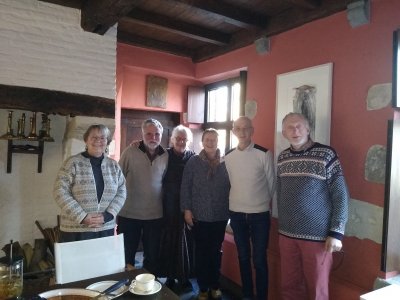
2023, February.
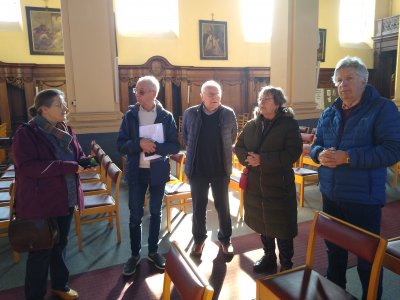
Hilde and Pete visit Bottelare again, meeting Lieve and local parishioners and parish council members. Fr Ambrose had previously suggested a memorial plaque to honour Fr Theophilus and give thanks for his service in Shetland. Enthusiastic response, suggestions of special unveiling in 2024 including a visit from a small pilgrimage group from Shetland.
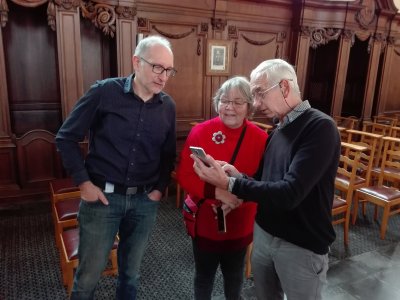
2023, July.
Lieve comes to Shetland in Fr Theophilus' footsteps to meet Fr Ambrose and see all the places where Fr Verstraeten lived and worked. Plans firmed up for a memorial plaque ...
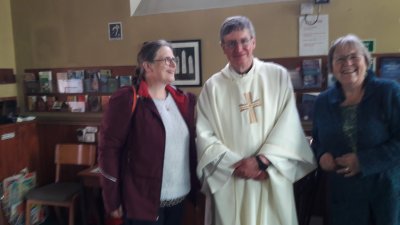
Now we invite parishioners to raise money for the plaque and come to Belgium for the unveiling!
2024
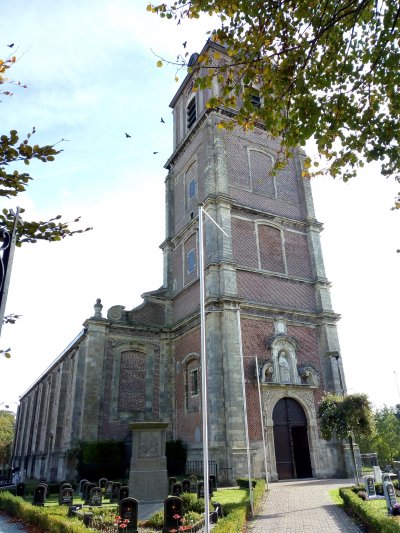
October ... Pilgrimage Lerwick to Bottelare.
Finding Mary Nicolson
6 Aug 2023
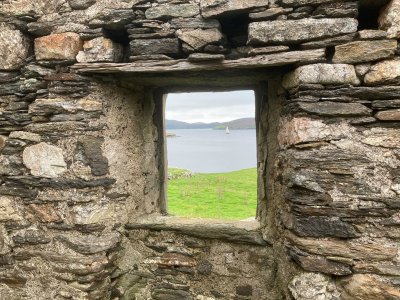
Mary Nicolson was born in a croft on the shore of Aith Voe sometime around 1780. The ruins of the building are still to be seen at Queensetter and the photograph shows a view she must have been familiar with as a child, looking across the sea to the island of Papa Little. Her brother, John Nicolson, is remembered in Shetland as one of the pioneers of the Methodist church in Shetland and his achievements are listed on his gravestone in Gruting.
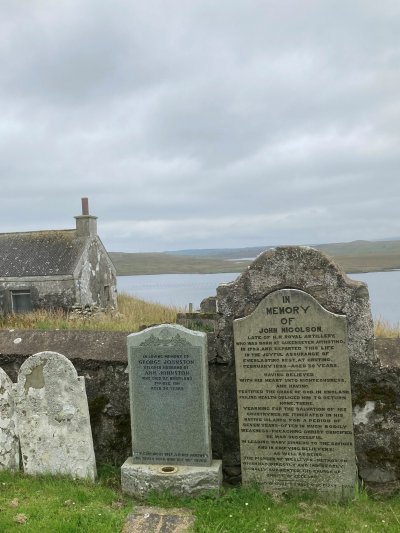
Mary had a much quieter life as the wife of a fisherman. She could have passed from this world almost completely unknown but for a strange episode two months before her death, which was celebrated by Catholics as a sign of God's loving Providence and by contemporary Protestants as a sign of Popish trickery. An account published in the Northern Ensign newspaper on 14th July 1861 was picked up by "The Bulwark or Reformation Journal" on 2nd September 1861 and given national circulation, complete now with an imaginative reconstruction drawing. Despite the anti-Catholic tone, the account is a valuable account since it comes from the testimony of Mary's son, an eye witness.

The account describes a journey by three men from Lerwick to South Delting, a distance of 19 or 20 miles. Only one of them is identified - Martin Flynn, an Irishman, who was well known in Shetland. Their object was to meet with Mary Nicolson and a woman had been sent ahead a day or two before to find out if Mary would be well enough to receive them. One of the group was introduced as a "Dutch Doctor", and the party gained admission to the house on the understanding they could give medical advice.
[The Dutch Doctor] "then proceeded to examine the patient, feeling her pulse, lifting up her eyelid, looking very grave, &c. He then took out a little bottle containing some liquid, which on being uncorked diffused a sweet odour. He applied it to her nostrils and otherwise, going through a number of other motions, which they did not well follow him in. He also said his companion was a minister, and that if they were agreeable he would pray. Assent was readily given, as the thought had not yet struck them that he might be a Romish priest. The Doctor and he spoke to each other a good deal in some foreign language - it might be Latin. The minister took out a small book, and read in an indistinct under-tone a good deal from it, but nothing of what he said was understood, or could even be distinctly heard by those present. They tried to get the sick woman to converse with them; but, being prostrated by paralysis, she could get almost nothing intelligibly uttered, except yes or no. They asked if she would be glad to see the priest? She said yes. The Doctor told her this was one. The people of the house were horrified at this disclosure, but they could not now help themselves. The scent bottle had already been applied ad libitum, and the whole was, it seems, accomplished - baptism, extreme unction, and salvation. The Doctor insisted that they should remain by her for the night. This could not be conceded. The house was not such as that gentlemen such as they could be accommodated in it. "Oh, no," they said, "we can remain perfectly well." Mary's son, however, was resolved that out they must go, even if force should be requisite. They at length asked to be conveyed by boat northwards, and I think the young man said they took them by boat to Olnafirth."
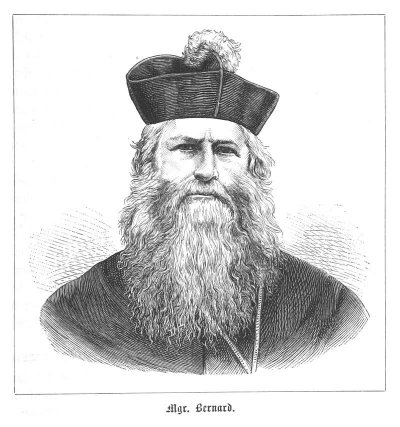
We have an account of the reception into the Church of Mary Nicolson also from the Catholic side. Fr Etienne Djunkowsky, Prefect Apostolic of the North Pole Mission, had arrived in Lerwick on 30th September 1860 and celebrated Mass that same day in the Zetland Hotel in Commercial Street. It was probably the first Mass in Shetland since the Reformation. Djunkowsky had travelled with Dr Olafur Gunlogson, an Icelander who had been resident in Belgium before attaching himself to the North Sea Mission, and on 7th October had been joined by Fr Bernard Bernard and Fr Theophilus Verstraeten. The unnamed priest in the dialogue was Fr Bernard Bernard. He gave his own description of events in a letter to Rev. X. Ciamberlani, Belgian Procurator of the North Pole Mission, sent from Lerwick on the 14th October 1860 and published in Brussels in 1861.
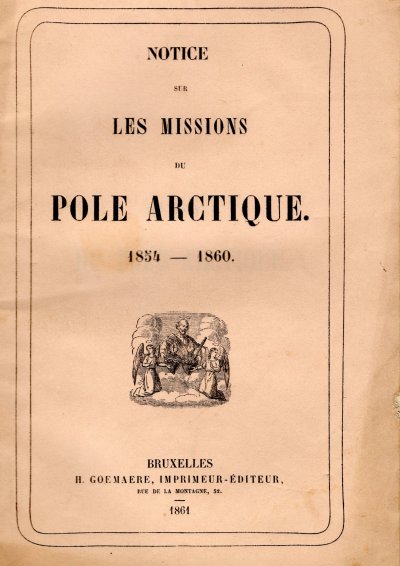
About eighty years before the time of writing, a married couple who were without children had prayed ardently for a child. They were Protestants but had none the less maintained respect for ancient Catholic traditions. They promised God that if he gave them a child they would name him after an apostle, if it was a boy, or after the Mother of God if it was a girl. Their prayer was heard and the new-born child was named Mary. When Mary grew up and was married - she was about 40 years of age at this time - she saw a mysterious person who told her that if she wished to please God, she should become a Catholic. At this time she knew nothing of Catholicism and there was no priest in the islands, but she learned something of the Catholic faith from Irish pedlars who travelled round Shetland, and often declared that she wished to become a Catholic. Another 34 years passed and God consoled her again, she had said. It was revealed to her that she would die a Catholic, and that a priest would be sent to her - notwithstanding all the difficulties - and would make her a child of the Roman Church and administer the sacraments to her.
Bernard tells a story which mirrors the 'Ensign' article almost exactly. On arrival in Lerwick, Djunkowsky had been told of Mary Nicolson. The missionaries were aware that she was now about 80 years of age, seriously ill and paralysed, and was either dying or possibly already dead. That explains the messenger who was sent on ahead a couple of days before the events described above. The Prefect Apostolic had asked Fr Bernard to go to Mary and provided him with a guide [Martin Flynn] and a companion who could act as interpreter [Dr Olafur Gunlogson?]. They were aware of the difficulties of the route, the possibility that Mary would die before they reached her, and the hostility of the family to the Catholic faith, but pressed on regardless through hail and strong winds. When they reached the bedside of Mary Nicolson they found her almost senseless and unintelligible in her faint speech. But at the words, "a Catholic priest is here, he is here beside you" her senses returned and her tongue was loosened. She thanked Jesus that he had granted her the grace so long desired and requested, and which he had promised. To the astonishment of the members of her family she clearly professed that she wished to die in the faith of the Catholic Church. She was conditionally baptised, and received also the last rites. She showed great joy and seemed to recover her strength a little, asking to hold the hand of the priest God had sent to her.
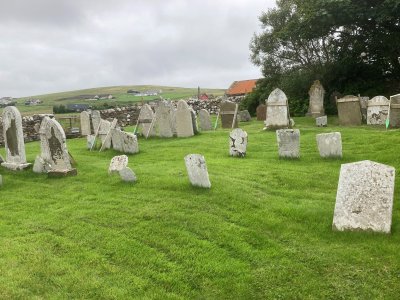
Mary Nicolson died two months later, on 12th December 1860, and lies buried somewhere in Aith old cemetery. Other stones from this period indicate the likely area where she was laid to rest, but there is now nothing to mark her grave.
Brownie Barnes, RIP
19 Feb 2022
Brownie (Cecila) Barnes died on Sunday 6th February at the age of 89. May she rest in peace!
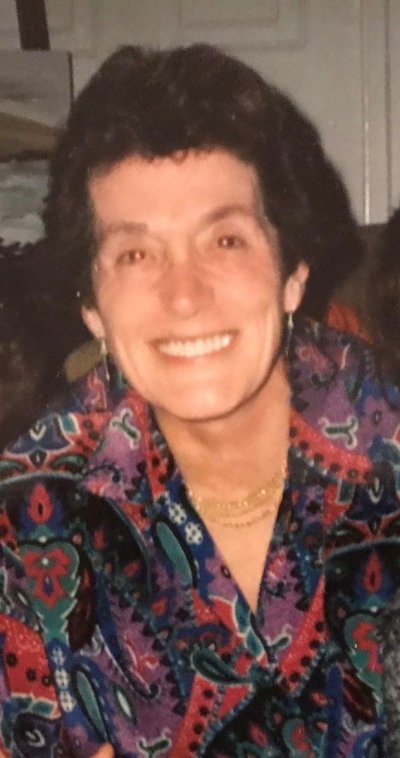
The following is the eulogy given at Brownie's funeral by her daughter, Grace Barnes:
There are so many words that can be used to describe the woman that Celia, Norah and myself knew as Mum (and Nana), but who you all knew as Brownie. And words were something that Mum loved. Books, poems, crosswords … hers was a life filled with words. These are just a few which I have heard used in regard to Mum in the last few days. Witty. Kind. Feisty. Talented. Gracious. Wonderful. Irascible. Charming. Intelligent. Encouraging. Glamourous. And my favourite, formidable. Mum always claimed that she would duck into the nearest empty cupboard or classroom if she saw Nessie heading towards her in the Anderson … but I suspect it was the other way around. A question that is often asked about Mum is, why was she called Brownie when her given name was Cecilia? Well, the story she told, is of being a little girl on holiday in Ireland with her father’s large and unforgettable family, the O’ Flahertys. Watching the then three-year old, Mum, playing on the beach, one of the Aunts noted her suntan (even then) and declared that Cecilia was much too big a name for a child, and Mum was a little Brownie. And the name stuck.
Mum was born in Glasgow in 1932, and attended St Joseph’s Convent in Girvan, before going on to Glasgow University to study English. At University she met Robin and they were married in 1962 and moved to Edinburgh where Celia, Norah and I were born. In 1972 we moved to Shetland where Mum quickly established herself within the community. She played badminton every week at St Clements Hall and squash at Islesburgh. She was on the committee of the Shetland Arts Society, a group which brought classical musicians up to Shetland to play concerts at the Town Hall. When the swimming pool opened on the Hillhead, Mum began a relationship which developed into one of the greatest loves of her life: swimming. She was a volunteer with the Lerwick Amateur Swimming Club and acted as timekeeper for Inter County. And for almost three decades she was a volunteer with the swimming classes run by Ability Shetland. Mum was still swimming regularly until she had the stroke three years ago and she is fondly remembered by the staff at Clickimin; Anne and Linda told me last week that Brownie always made them laugh.
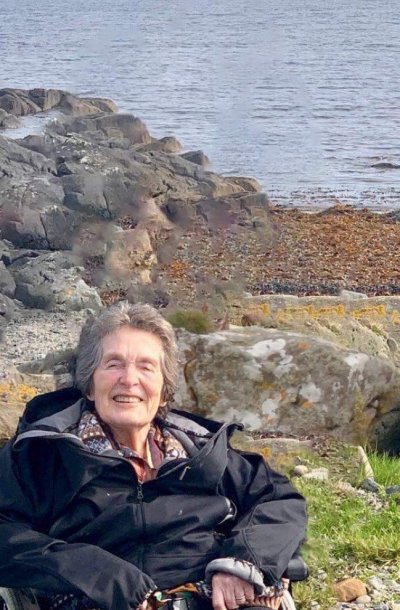
Mum loved to entertain, and she was the life and soul of parties with the drama group and at Greenfield. She was, as Jessie remembered, a very glamourous addition to the Kvelsdro lunch set. She had a great sense of style - who can forget the white platform shoes? She was a skilled dressmaker and would waft in on a cloud of ‘Blue Grass’ perfume on her way out to the Lifeboat Ball in another wonderful, gold lame creation she had made for the occasion. She loved fancy dress and her skill on the sewing machine was evident every year on Gala Day when a willing, youngest daughter and not-so-willing, Inkster neighbour stepped out in the fancy dress parade in another one of Mum’s feats of the imagination. Mavis reminded us of Nessie’s medieval themed retirement party when Mum appeared as a serf and spent the evening carrying around a real pig’s head on a plate.
Brownie’s creativity could also be seen in the themed cakes she made for the Islesburgh Drama Group panto. The clock for ‘Hickory Dickory Dock’ was a triumph of engineering, but the icing on the cake celebrating ‘The Grand Old Duke of York’ didn’t set in time and the 10,000 men slid down the hill and lay in a defeated heap at the bottom. Mum was, of course, a teacher and for almost forty years she taught English, not just at the Anderson High School – also at Brae, Whalsay and Scalloway. She had some unorthodox methods of maintaining discipline: quite a few people have mentioned the well-aimed piece of chalk that came flying across the classroom. Brownie hated social injustice and firmly believed that everyone should have the chance to shine. Perhaps that’s why she had such a passion for adult education: the number of people who say, ‘she got me through my higher English’ is a testament to her commitment. When she retired, she tutored a new generation and relished the opportunity to share again the intricacies of ‘Dulce et Decorum Est’, and ‘Death of a Salesman’. Her love of learning never diminished, and she did so many Open University courses that I used to tell her she must have a PhD by now. She loved to study the ancient civilisations – the Romans, the Mayans and the Egyptians. I have a clear memory of visiting the ancient Turkish city of Ephesus, and Dad and I laughing because Mum kept correcting the tour guide. Mum did struggle after Dad died, but when she moved to Thorfinn Street, she found a whole new community and talked delightedly of the fun nights she had with the neighbours who would come round to eat meringues and cream and sing songs around the piano. Brownie was an accomplished pianist and the three of us fell asleep many a night listening to Mum and Dad playing duets in the next room. Mum also played duets with Dierdre and with Cyril, and she played the organ here in St Margaret’s for evening Mass for decades: one unsuspecting priest once made the mistake of changing Mum’s choice of hymns. Suffice to say, he never did it again. She also never missed a folk festival and loved having the visiting musicians to stay in Greenfield.

Brownie is known to many folk in Lerwick as ‘the wife wi da peerie dugs’. She had a succession of Yorkshire terriers and when Tammy and Beanie were puppies, she sewed pockets into her jacket and popped them inside. She would then go down to the street with the two peerie heads sticking out of the top of her parka. When she moved into ET House, we regularly borrowed dogs to take in to see her. In her final weeks, Frank very kindly lent us Frankie and Oskar, tiny Papillons, to lay on her bed so she could stroke them. ‘Lovely’ she managed to say. On Mum’s birthday during lockdown, Maggie Kay and Melanie rounded up a small pack of dogs and sat them on the wall outside ET House all wearing party hats. And Mum couldn’t have been happier.

Other things that Mum loved are an eclectic mix. The Mediterranean sun. The Last Night of the Proms. The Sound of Music. Chitty Chitty Bang Bang. The Grand National. Amusement arcades. The novels of Ursula le Guin and Rumer Godden. She loved Glenn Miller. Vera Lynn. Over the Rainbow. She loved ice cream and aniseed. Inspector Morse and Gene Kelly. Brass bands and line dancing. She loved card games - spent endless hours playing patience on the computer - and taught us to play whist. She was a long-standing member of the Lerwick Bridge Club. She loved theatre. Musicals. Puzzles and board games. Dad’s Army. She loved Frank Sinatra, which was apt, given that Brownie was someone who absolutely did it Her Way.
There are so many people to thank, particularly in the last three and a half years when Mum was at ET. The visitors, the dog walkers who always waved when they passed. The wonderful staff who not only cared for Brownie with kindness, but with great love, and who ensured that her last years were happy and free of the anxiety which had plagued her. There are no words to thank Julia, Wendy and Alan who were with Mum at the end. It is our duty as a community to ensure that the dedicated and committed people who care for our elderly and our vulnerable are given the support, emotional and financial, that they so richly deserve.
As Father Ambrose said last night, this is a life complete. A full and well lived life, by someone who touched many people. And many dogs. I’m going to end with lyrics from a song that Mum loved. It’s from a musical named ‘Wicked’, and these words sum up how we feel about that feisty, fun, glamourous and intelligent woman we knew as Mum. And you knew as Brownie.
I've heard it said
That people come into our lives
For a reason
Bringing something we must learn
And we are led to those
Who help us most to grow if we let them
And we help them in return
Well, I don't know if I believe that's true
But I know I'm who I am today
Because I knew you
It well may be
That we will never meet again
In this lifetime
So, let me say before we part
So much of me
Is made of what I learned from you
You'll be with me
Like a handprint on my heart
Like a ship blown from its mooring
By a wind off the sea
Like a seed dropped by a sky bird
In a distant wood
Who can say if I've been changed for the better
But because I knew you
Because I knew you
I have been changed for good.
Shetland Pilgrimage 2021
25 Jun 2021
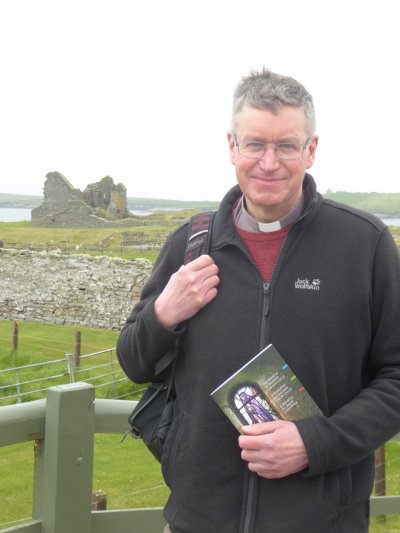
Before Covid struck, I was planning a long pilgrimage to Rome along the Via Francigena. That seems now like an impossible dream, but a friend told me of a virtual pilgrimage he was making in support of the Friends of the Holy Land. He was walking in stages near his home a distance equivalent to the journey from Bethlehem to Nazareth. The idea was to raise funds for the school fees of Christian families in the Holy Land, many of whom have lost their source of livelihood during the collapse of the pilgrimage and tourist industries.
The distance from Bethlehem to Nazareth is much the same as the length of the main island of Shetland, so I decided to walk from Sumburgh Head to North Roe in stages through the month of June. This is the most beautiful season in the Northern Isles, with the simmer dim and the land vibrant with birds and flowers.
I wanted to support disadvantaged the disadvantaged Christian school children in the Holy Land, but I saw it also as an opportunity to celebrate the 1500th anniversary of the birth of St Columba of Iona by visiting as many as possible of the sites associated with the Celtic monks who brought the faith to the Shetland Islands. Other parishioners and a Church of Scotland Minister joined me for sections of the walk and we formed a team, "Shetland Pilgrimage". What follows is a transcript of the daily blog I posted on the charity's website.
Day 1. Sumburgh Head to Robins Brae. Distance: 10.89 miles.

We started the pilgrimage on Monday 31st May. Marsali joined me for the first four miles and we did a loop from Jarlshof to Sumburgh Head. No sign of puffins. The lighthouse was quite atmospheric with the swirling mist. I had to get permission to cross the airstrip but it was a technicality since all flights today had been cancelled because of low visibility. From Toab I walked along the beach of Quendale Bay, then on minor roads through Quendale, Dunrossness and Boddam, returning to Lerwick by bus. Total distance 10.8 miles, equivalent to the distance from Bethlehem to the Holy Sepulchre in Jerusalem. The picture is of Marsali with Sumburgh lighthouse in the background. This is the southern tip of Shetland Mainland.

Day 2. Robins Brae to Sandwick. Distance 12.94 miles.
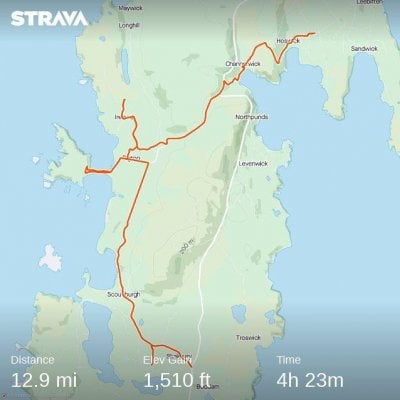
Fog again first thing, but it cleared to a glorious summer's day when I crossed to the west coast. This is one of the most fertile parts of Shetland with dairy and arable farms besides the ubiquitous sheep. There were seals sunning themselves on the beach at Reawick Bay. Since this is a pilgrimage in honour of St Columba I detoured to St Ninian's Isle. The chapel there may have been founded in the the seventh century by Celtic monks. I also sought traces of the Norse period steeple Kirk at Ireland, but found only a Methodist chapel. Today's route almost completely avoided the main road. I cut down to Channerwick Bay cross country and reached Sandwick via Rompa and the pretty fishing village of Hoswick.
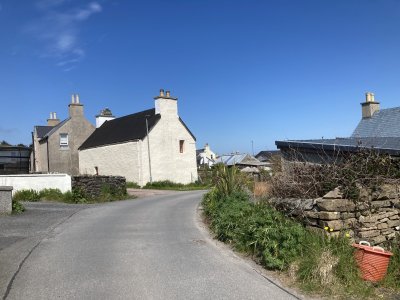
Day 3. Sandwick to Quarff. Distance 11.59 miles.
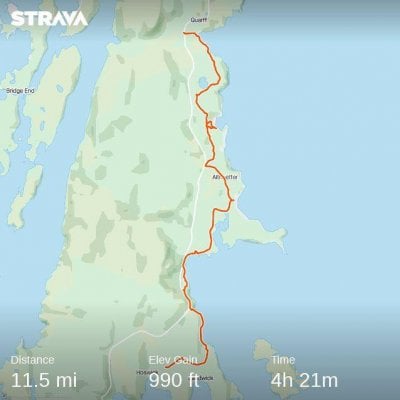
Only eleven and a half miles today but it felt like much more! The sun was strong and most of the walk today was off-road. I followed the coast along Mousa Sound, opposite the famous Iron Age defensive broch. A display board said it was one of the best places in Britain to see whales, porpoises and seals but none broke surface while I was there. North of Cunningsburgh I visited the abandoned village of Fladderbister. A group of old crofts from the eighteenth and nineteenth centuries are roofless but give a good idea of what Shetland was like up to the 1930s. There are also two well preserved lime kilns. I was bracing myself for a five mile stretch of main road but found an access path leading to Fladderbister Loch and the coast. The track soon disappeared and I had to pick my way through heather, rock outcrops and bogs. I feel I have a better understanding now of what is meant by the 'trackless desert'. It was with some relief that, on clearing a ridge, I spotted the familiar outline of Quarff Kirk.
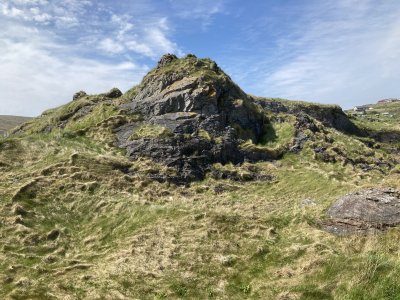
Day 4. Quarff to Scalloway. Distance 4.8 miles.
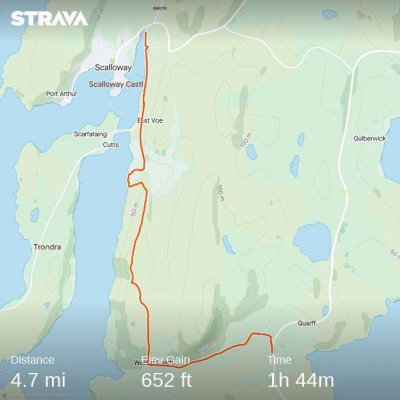
A short section down the Quarff valley, then following the ridge cross-country along the west coast to Scalloway. I was accompanied by Pete and David. Wonderful views over Tondra and Bura right out to Foula. One of the islands of this group is called Papa, normally a sign of a Celtic monastic presence. Our end point, Scalloway, was the administrative centre of Shetland until the eighteenth century. The ruined castle dates from the early 1600s and was the home of the Stewart earls.
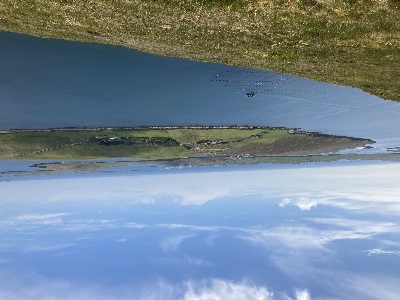
Day 5. Papil to Scalloway and Lerwick. Distance 17.85 miles.
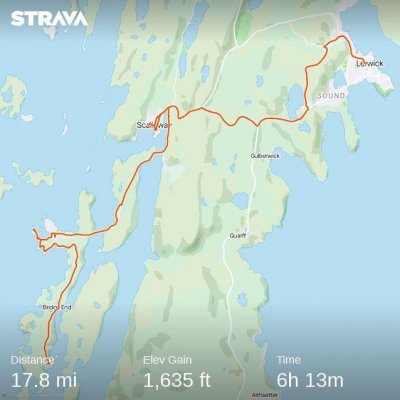
Today is the feast of St Columba. I branched off my route to visit Papil on Burra Isle, a Celtic monastic site. The isles of Burra and Todra are joined to the mainland by fixed links. Visited the lighthouse at Hamnavoe then on to Scalloway where I rejoined my route. I would have been too late for my bus at Tingwall so continued to Lerwick. 17 miles total. Steady drizzle p.m.
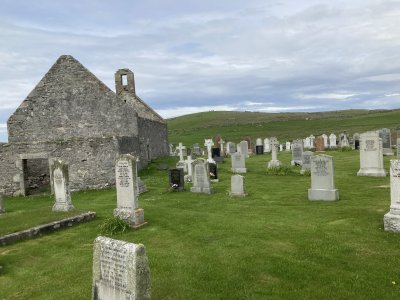
Day 6. Lerwick to Bressay and Noss. Distance 9.48 miles.
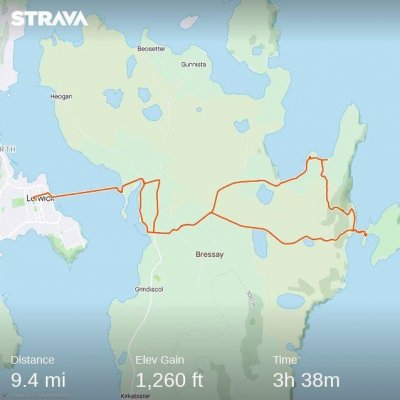
Crossed Bressay Sound, Lerwick's harbour, with Pete. Low cloud and light rain meant we were in and out of waterproofs all day. Crossed to the island of Noss, a National Nature Reserve, in a rubber dinghy. The wind was picking up and a heavy swell was making the crossing dangerous so the Warden decided to return us almost immediately to Bressay. Just time to find the site of the Pictish chapel where shrine fragments were found in excavations. We climbed Ander Hill to the First World War lookout, then down to the early Christian churc site at Cullingsbrough, beside an Iron Age broch. The Bressay Stone was found near here. This is the furthest east we shall go. Returning now to the main journey north.
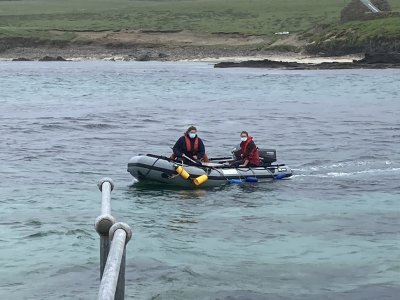
Day 7. Lerwick to Bixter. Distance 16.16 miles.
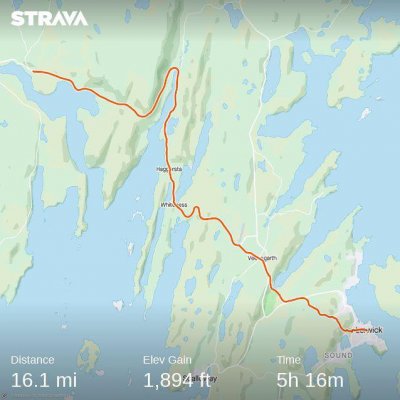
High winds and intermittent rain. Apart from two short cuts I kept mainly to the roads. My route has taken me in a NW diagonal line to the West Side through the Tingwall valley back to the west coast. The photo is of Weisdale. In the nineteenth century clearances 300 families were evicted from this fertile limestone valley to create pasture for sheep. Many emigrated. In the backgound is Upper Kergord which is soon to be transformed by the largest windfarm in Europe. It is expected to supply much of Scotland's energy requirements and for the first time Shetland will be connected to the national grid.
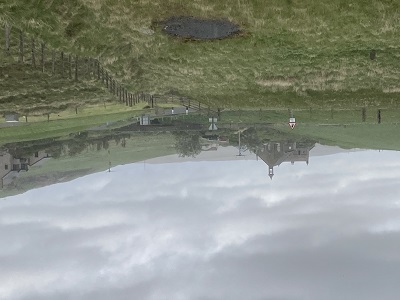
Day 8. Bixter to Brae. Distance 16.27 miles.

I completed exactly 100 miles at Brae bus stop. Definitely in the north now. The first part of the day took me through hilly, but scenic, terrain from Aith to Voe. The second part was more difficult going, on steep sheep tracks along the coast. I was glad to find an alternative to the hard shoulder of the highway. Voe is one of my Mass centres. The photo shows a monument to the opening of Voe Marina.
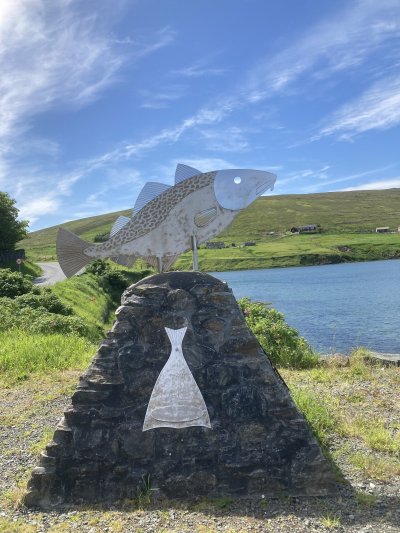
Day 9. Brae to Urafirth. Distance 12.07 miles.
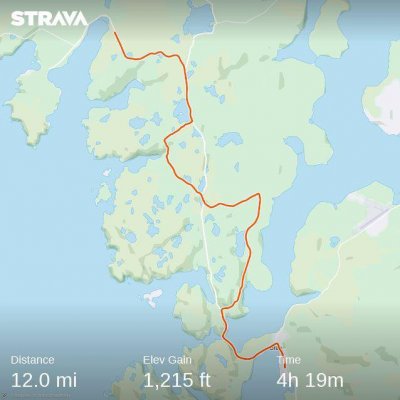
I was joined today by the Rev. Lynn Brady, Church of Scotland Minister for northern Shetland - and Max, her two year old dog. We crossed the narrow isthmus at Mavis Grind into Northmavine. This is volcanic territory. Shetland has a really complex geology. From Sullom we were able to look across to the huge industrial plant at Sullom Voe, once the centre of the North Sea oil operation. One cross-country section near Gunnister. The scenery was almost Alpine. At 12 miles, this was Max's longest ever walk but he was still playful at journey's end. Almost there now. My final destination of North Roe is about ten miles away.

Day 10. Urafirth to North Roe. Distance 10.12 miles.
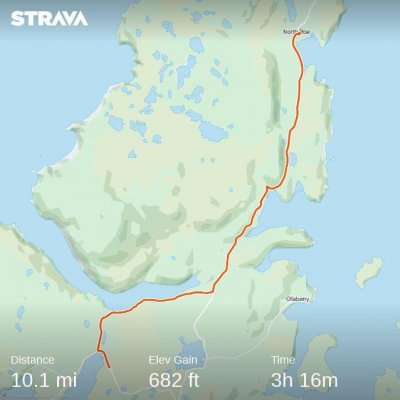
I started my walk along Ronas Voe, which is dominated by Ronas Hill. At 450 metres it is Shetland's highest point. The hill is the eroded magma chamber of an extinct volcano. Continuing northwards, I passed near to the breeding grounds of Arctic terns and they swooped on me repeatedly to drive me off. The Shetland name of tirricks better suggests their character. Marsali joined me for the last section into North Roe, where we were given a warm welcome by the volunteers in a beautiful community garden alongside the old Kirk. This is our Nazareth. We have reached the end of our journey, 122.2 miles from Sumburgh.
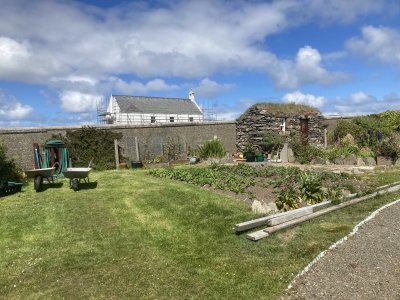
Coda. Point of Fethaland. Distance: 8.87 miles.
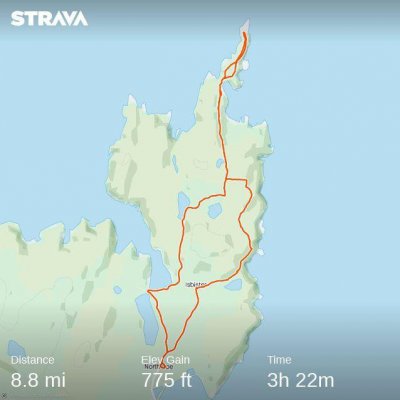
The road ends soon after North Roe, but there is a promontory which extends about five miles further north. I decided to return in the evening to complete the island "end to end". It was the summer solstice and I arrived at the headland at 11 p.m. when the last rays of the settings sun were still showing on the horizon. I walked until 1 a.m. and it remained light throughout. This extension also gave me an opportunity to visit Kame of Isbister, thought to be a Celtic hermitage site. A tranquil end to the pilgrimage. The photo shows the Point of Fethaland in the "Simmer Dim".
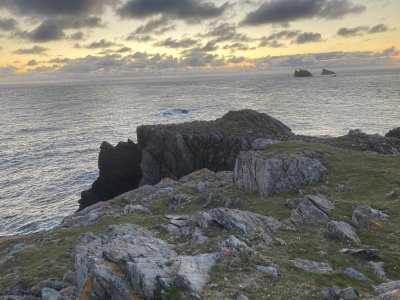
New Liturgical Books
29 Nov 2020
The Abbey Psalms and Canticles
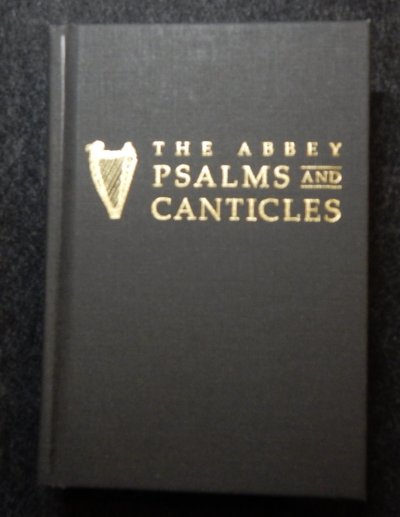
Despite COVID-19, and all the delays that have come in its wake, 2020 has proved to be an important year for Catholic liturgy. In February the United States Conference of Catholic Bishops published the definitive version of the revised Grail Psalms translation which will form the base of the revised Liturgy of the Hours and also be used in the new Lectionary.
Oddly, for a text which has not yet been fully "launched" in the United Kingdom, this translation is now circulating in three distinct versions: the "Revised Grail Psalms" prepared by the Benedictine monks of Conception Abbey, which was approved by the Holy See for liturgical use in 2010; the text edited by Dom Henry Wansbrough and incorporated into the "Revised New Jerusalem Bible" last year; and now this "Definitive Version" which has been brought out after the US Catholic Bishops obtained the copyright in 2018. There are a surprising number of changes to the 2010 text, some of them a little jarring. For example, in Psalm 117 the familiar stanza
"It is better to take refuge in the LORD / than to trust in man; / it is better to take refuge in the LORD / than to trust in princes."
has become, "It is better to take refuge in the LORD / than to trust in anyone else; / it is better to take refuge in the LORD / than to trust in princes."
Generally, though, it is a beautiful translation and this new printing has the added advantage of being published with the Canticles from the Old and New Testaments used daily in the liturgy. These, like the psalms, are the final version approved for use in the US in future liturgical books.
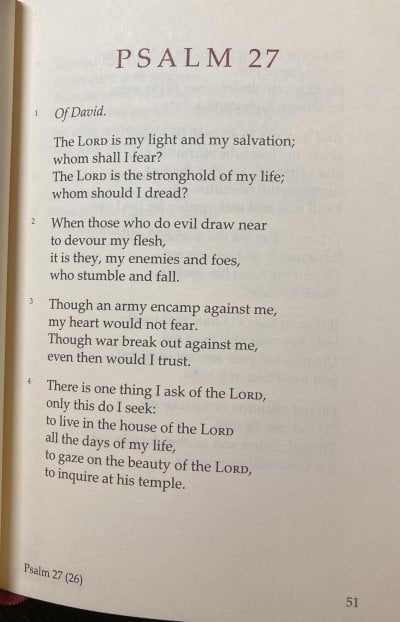
The book is handsomely printed on thick cream paper, cased in a slate-grey hard cover. It is available from the USCCB website in the US or from Amazon in the UK.
Antiphonale Romanum.

Gregorian chant is normally associated with monastic liturgy, but following on from their work on the Antiphonale Monasticum, the monks of Solesmes have now published a two volume antiphonal to accompany the Roman Office. Volume 2 came out in 2009 and gives all the texts needed to sing the office of Vespers (Evening Prayer) on Sundays and the greater feasts. Volume 1 appeared earlier this year and gives the texts and music for the Invitatory and Lauds (Morning Prayer). Unlike the corresponding monastic volumes, these are designed to stand alone and include the Gregorian hymns, antiphons, psalms, readings, intercessions and prayers. They are in Latin throughout, although of course it would be possible to use the musical items alongside the English-language Liturgy of the Hours. It is a shame that the short office of Compline was not included in the Vespers volume.
Available from the online shop of Les Editions de Solesmes.
The Neumz App.
Although not strictly a liturgical book, the Neumz App, which was launched on the First Sunday of Advent (29th November 2020), is a valuable resource for anyone who wants to deepen their knowledge of the Gregorian musical heritage of the Catholic Church. It is part of a massive project, and makes available more than 7,000 hours of Gregorian Chant. Engineers of Odradek Records are recording the Benedictine nuns of the Abbey of Jouques in their daily office through the course of the entire three year liturgical cycle. The free version of the app allows you to listen to the daily office sung in its entirety. Subscribers have access to all the texts on demand (selected by date), with recording, musical texts and translations available simultaneously. The promotional price is 6.99 Euros a month. Two thirds of the revenues from subscriptions will go to the sisters to support the community of Jouques and their foundation of Notre Dame de l'Ecoute in Benin. You can download the Neumz app from App Store or Google Play, or subscribe to their YouTube channel.
More information can be found on the Neumz website.
The Praglia Antiphonale Monasticum.
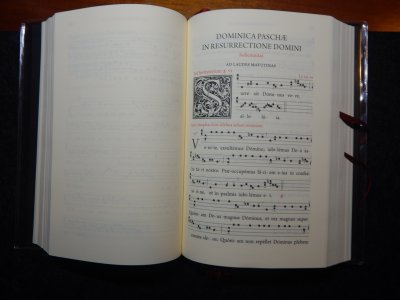
In October the monks of Praglia in Northern Italy published the second volume of their long awaited Antiphonal. It is now complete in two volumes: the first, 'De Tempore', has all the music required for the Seasons of the Year and the Sundays in Ordinary Time; the second, 'De Sanctis', has the antiphons, hymns and responsories for the Sanctoral, including the common offices and also the Latin psalm antiphons for the ferial office. They are designed to accompany 'Schema B', a Benedictine arrangement of the psalms which spreads the Psalter over one week without repetitions (the Roman Office spreads the Psalter over a four week cycle).
Earlier choir books produced by Praglia had been in Italian. These two volumes are clearly intended for a more international market and are entirely in Latin, apart from the preface which is presented in Latin, Italian and English. They are beautifully printed, with sturdy bindings and gilt edges but, unlike the Antiphonale Romanum, would need to be supplemented with additional liturgical books for the readings, prayers and intercessions. The Italians have these in Praglia's 'Liturgia Monastica delle Ore', but since the Praglia books take these items from the Roman Office, the gaps could be filled by the Latin edition of the 'Liturgia Horarum' or from the English Liturgy of the Hours. The Solesmes 1981 edition of the 'Psalterium Monasticum' can be adapted to Schema B and has Gregorian antiphons for all the psalms and canticles.
The Praglia Antiphonale Monasticum has been produced by a team of musicologists who have based their restoration of the authentic melodies of the chants on the manuscripts of Hartker preserved at St Gall in Switzerland. These date from the years 980-1011. Where material is lacking, these manuscripts have been supplemented by by others from across Europe, but for each melody, only one manuscript has been chosen and faithfully transcribed. The publication of this antiphonal is a major event, since it brings to an end over 50 years of enforced musical improvisation for any monastery trying to follow Notker Fueglister's Schema B. Some of the Gregorian melodies are notably different from those in the the Solesmes antiphonal, and it may be a challenge for communities to learn this new repertoire.
Sample recordings of the chant (Registrazioni mp3), together with more information on the project, can be heard on a new website dedicated to the Novum Antiphonale Monasticum (go to the "More ..." tab).
The recordings can be downloaded as zipfiles. They are arranged by liturgical season and cross referenced to the Antiphonal.
These new liturgical choir books compiled for the Benedictine Schema B are available from the website of the Monastero di Praglia. Details of prices and availability are given on the website.
Fr. Ambrose Flavell, updated 22nd February 2021. My thanks to Sr Maria Ruth Malagoli, osb, of the Abbazia benedettina Mater Ecclesiae, Isola San Giulio - Novara for additional information on the New Monastic Antiphonal.
Michael Anthony Duffy, R.I.P.
26 May 2020
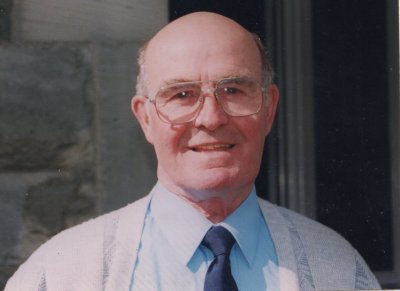
Mike Duffy died peacefully at Taing House, Lerwick, on 14th May 2020. He was 88 years old.
Mike was from a large family and kept his ties with Ballybofey in Donegal all through his life. As a young man he had moved to Britain and was living in London at the time of his marriage to Sheila in 1964. They got married in our parish church of St Margaret with the wedding celebrated by Fr Brian Riordan, S.J.
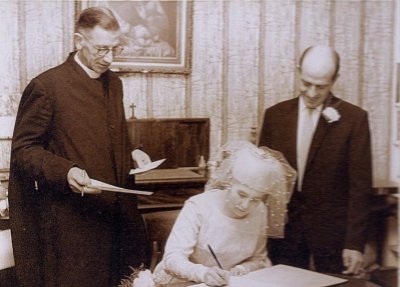
This is one of the few photos we have of the interior of St Margaret's Church just ten years after the Jesuits arrived to set up the parish:
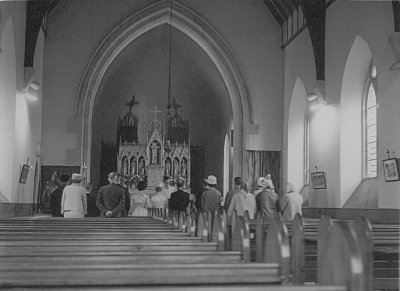
In the 1970s Mike and Sheila returned to Shetland and Mike was working as a carpenter during the expansion of the oil industry buildings at Sullom Voe. The hymn board in St Margaret's is an example of his handiwork.
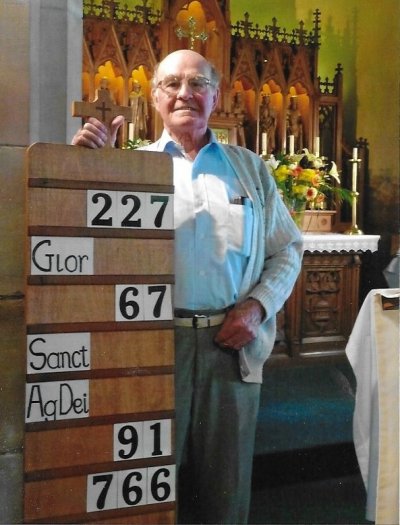
After news spread of Mike's death many people recalled his time as an usher at the Sunday Mass when his friendly welcome to visitors was often the lasting impression they took away from the parish. He had a strong handshake which he retained until the end. A fit and active man, he was still playing competitive football into his sixties.
In more recent years Mike was a regular at the Sunday Vigil Mass on Saturday evenings. When he began to have problems with mobility there was no shortage of friends willing to bring him to church in their car. He always sat in the same place, about six rows from the front, from where he would ring the consecration bell during the Mass.
Mike will be sadly missed. He is survived by his wife, Sheila, and three children. The burial was at Lerwick New Cemetery on 20th May and a memorial service will be announced for a future date.
May he rest in peace.
Locked Down in Snowdonia
25 Apr 2020
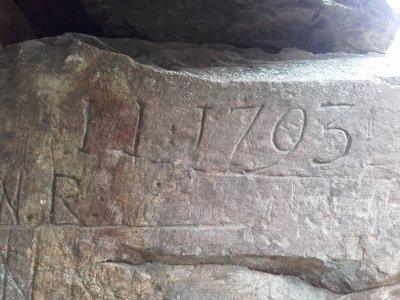
November, 1793.
This is proudly carved on the doorway of a drystone barn in the Nanmor Valley, in the heart of Snowdonia. One of History's seriously bad years was coming to an end with the official de-Christianisation of France. The Godess of Reason was celebrated in Notre Dame and Europe was in flames for the next twenty years.
Damned good news for sheep farmers though, because uniforms for our redcoats and tars had to be made from locally sourced wool. The price rocketed and it paid to improve the mountain pastures with enclosures, barns and so on, all made with the bounty of easily quarried stone.
Every winter I come here from storm lashed Shetland to repair the 11 miles of walls on my half sister & brother's beautiful farm. Here is a typical before ...
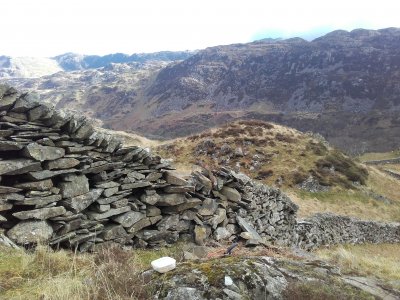
... and after patch:
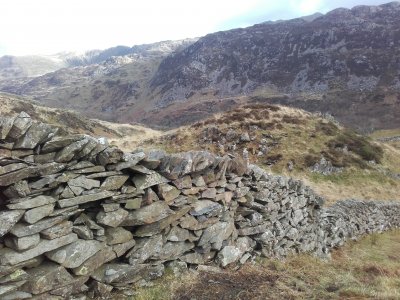
Now I seem to remember being told 2020 was going to be a "Fantastic Year for Us, for Britain!" Fantasy, indeed.
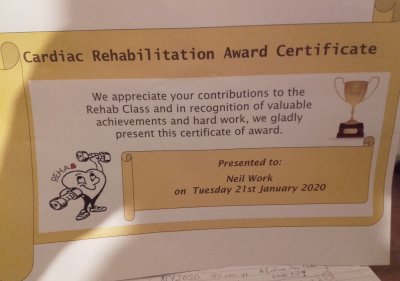
This year's visit to Carneddi (Welsh for "Stony Place"), for me, was meant to be a few weeks of gentle walling & climbing to build up my strength. I had heart valve surgery last September, and the G. Bain physios had certified me fit to do extra "Borgs". I have Katie to thank for this borg translation:
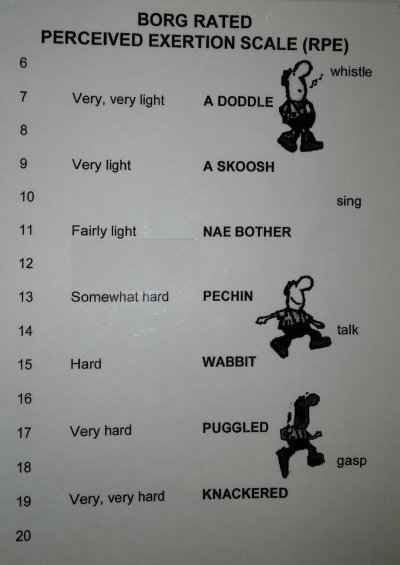
Between the tremendous rainstorms and odd hurricane I did a few little patches, bearing in mind 'Aunty Brenda's' advice: "Now, Neil, don't undo all the good work they did on you". (Brenda is a family friend who used to run a hospital ward.)
I had also the occasional fencing problem to work out, thus:

I had five weeks or so of this and was starting to think of onward travel when headlines started to intrude. I could see we were just 2 or 3 weeks behind Italy, where they were zoning & putting up barriers. Normally I would have gone on to visit other folk before heading "back op da rod", and realised this was off.
First news about the famous party bus was a message from Pete. I got more detail from friends in Nesting, then the usual very detailed report from workmate Tom. Tom is like the blind guy on the street corner the NYPD cop goes to in order to know what's the latest underworld news. It was interesting to hear how the schools were closed. I also read Osla Fraser's letter. All Shetland should remember her, & be grateful. I knew the viral storm was coming.
I could have rushed back. But discussing it with Ann it made more sense to stay put, I already had a real health issue & here I would get more of the cardiovascular exercise I was told to get. Here I could be more use, helping on the farm. Tom helpfully got me a couple of months meds from Levenwick to make this possible. Here is the box he sent me from covid hotspot Shetland, doing 3 days quarantine by the window.

14 year old Ffion was set up to do schoolwork from home. Where she occasionally plays tricks as her long suffering mother toils at the Aga ...
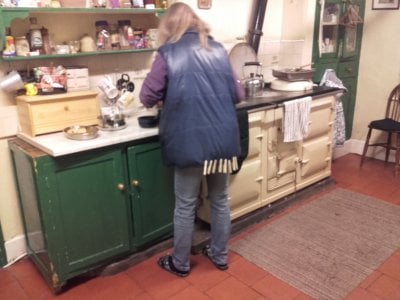
Ann works full time for the HMRC, & was soon remotely working from home. Fortunately her man, Brad, has a whole raft of technical skills. He once made a model Hawk jet plane. With working jet turbine. It crashed, but that was radio interference, not the jet. Anyway, despite the remote location he's got all the computer mystery stuff working o.k. to enable all this.
Then the sun came out ... and the primroses ...
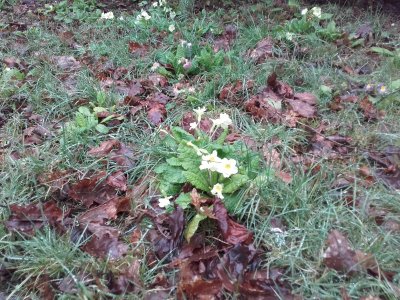
So here I was locked down. Snowdonia got into the headlines. First with unprecedented numbers of hillwalkers parking bumper to bumper. Then with all the "Scousers and people from Cheshire" (= vermin, to the Northwalian mind) invading to stay at their caravans on the coast & in their second homes, much to the despair of local GP's. That didn't last long though, and I saw none of this.
No, I was up the sunny mountain doing free repairs for Brian from over in Croesor who runs the next holding along. He's 75 & getting over a knee op. Ann had two weeks hols booked anyway, to do her lambing, and checked Brian's ewes as well. There's the same co-operation here like you get in Shetland. Brian returns the favours by coming with his big tractor & terrain skills to cut the bracken.
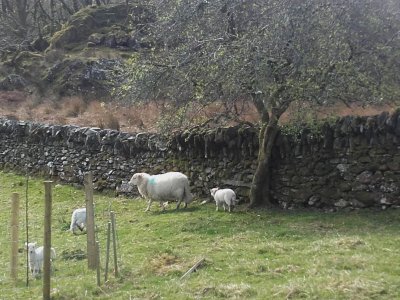
Mr. Fox got 2 or 3 lambs, and the Eyri Hunt hasn't been around to frighten him up the mountain, but the lovely weather meant lambing went well.
Weeks & weeks of sun, but where's the April showers? The poor grass isn't coming on like it should & they have to give more hand feeding than normal.
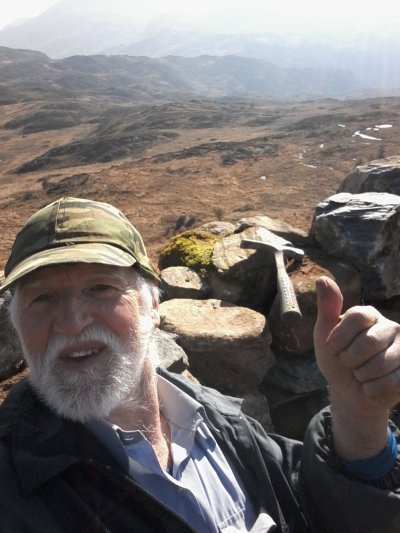
But, Spring. I've not seen a Southern Spring since my twenties. In Shetland the daffs come, then there's a storm, daffs flattened, then daffs again, (especially in Cunningsburgh thanks to that famous crofter who had to do community service), then a few more flowers & the hill starts to look less grey & then the tirricks and stuff come & it's slowly greener, but sometimes freezing.
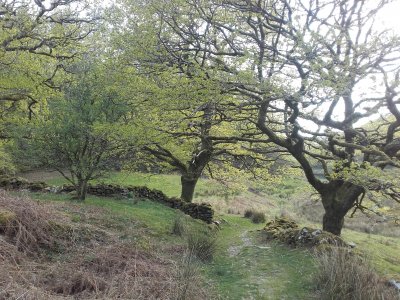
I'd forgotten how instant spring is here. I was amazed. Magnolias & other things in gardens I don't know the names of suddenly blooming. Birch, ash, oak, out within a week, all different shades of green. Butterflies chasing each other about in the wood. Funny colourful looking birds that Brad knows all the names of. Bluebells coming on in ones & twos, (I can spot them), which are about to form huge carpets judging by the leaves.

And now the canopy is closing down in the woodland. Yesterday I had to go down there to see if the ponies had running water to drink. I took Sam, who went on ahead, obediently stopping every time he lost sight of me, trying to guess which was I was going, acting all the time like a "ready to work, let's go" border collie every time a sheep appeared & looking back at me with pleading eyes. It was hot, over 20 degrees C. Then, down under the canopy, into the dappled shade, just right, so nice.
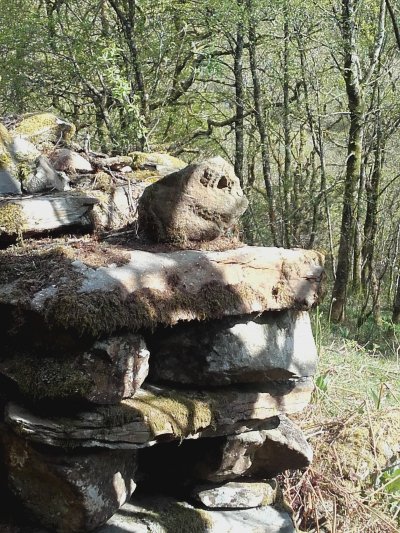
Where three weeks ago there was still bog the moss now crackled as we followed the hoof prints. We found the stream still trickling out from under the forest wall, upstream from the little dam built by the Yanks who camped here in 1944, and he lapped some up.
It's been doing this a lot the last few years Brad says. Lovely spring, then endless, endless rain, terrible summers.
The Simmer Dim beckons ...
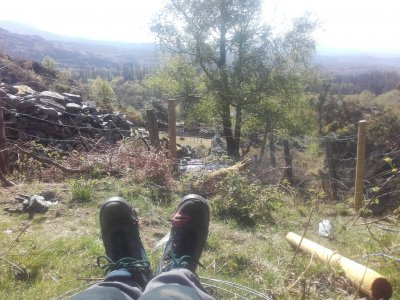
Neil Work, 25 April 2020.
Christopher Doig in Shetland
6 Dec 2018
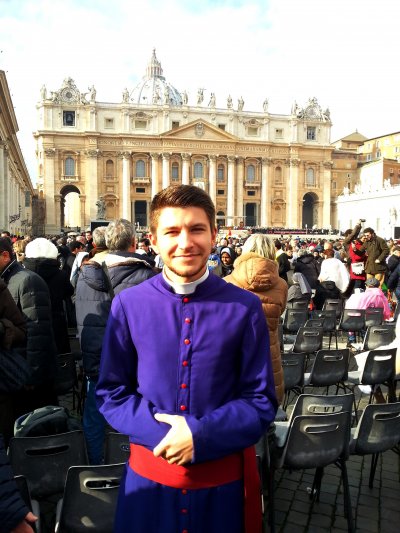
Christopher Doig, a seminarian at Scot's College, Rome, spent six weeks with us in the summer for his Pastoral Placement, 2nd August - 10th September 2018. He writes here of his experience in Scotland's northern-most parish:

This year's placement was unlike any other I've had in the past. The most exciting part about going to Shetland was the idea of taking a boat three hundred and fifty miles north. I got a great sense of freedom, abandonment and adventure as I looked back from the boat seeing Aberdeen in the distance under a blanket of grey cloud. It was the longest boat trip I have ever made; fortunately, the waters treated me well and it was a rather smooth journey. The way back, however, was another story.
Having slept for only four hours, I got off the boat at Lerwick harbour in a somewhat awakened state and went straight to the kitchen to help prepare refreshments for a funeral gathering. I really hit the ground running. It was a graceful day and I could see God at work.
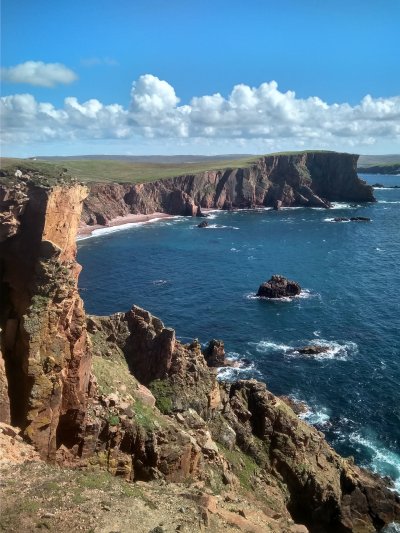
I wasn't quite sure what to expect for my placement because it is so different from any other place I have been to, but on that first day I was confident that it was going to be the highlight of my summer. When packing my case, I decided to bring three very important items. One of them was Dante's Divine Comedy. I thought that I would have a lot of time to read so that was a book I would get through in six weeks. In reality, I only just made it out of hell and began the ascent to purgatory (in no way did this reflect my time on Shetland - far from it!) Secondly, my sandals had to come too - I literally take them everywhere. As the weather was fantastic, they served me very well for my stay, apart from one or two days when I went walking on boggy land. And thirdly, I decided to take a kilogram of peanut butter just in case I didn't find any up on Shetland; to my surprise they had it in abundance and so it became a huge part of my island diet. It is rather good in a bowl of porridge and it even made its was into a curry when I was asked to cook one day.
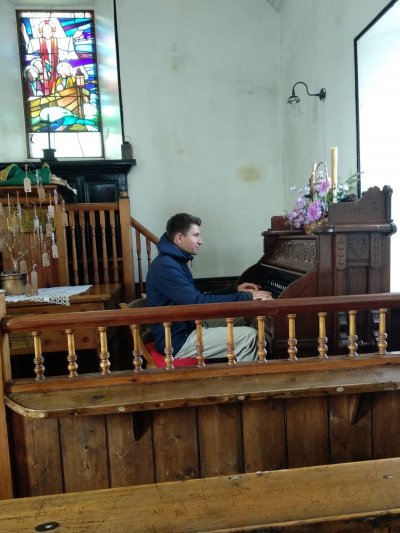
It was a very rewarding experience in the parish, especially now that I am an acolyte and have been given more responsibilities in serving the Church. Fr Ambrose and I made visits every week to the hospital, to one of the care homes and to see an elderly couple. I also got the chance to give a four-part Bible study on the Book of Jeremiah, something which was quite fresh in my mind after studying a course on the prophets earlier in the year. It was a great honour to lead Polish devotions for the Solemnity of Our Lady of Czestochowa in the small chapel where an icon of Our Lady rests. We sang the Marian hymn Czarna Madonna (Black Madonna), prayed the rosary and sang the Litany of Loreto.

Outside of parish work I was fortunate enough to have some time to explore some of what Shetland has to offer: Fr Ambrose and I went to see the Papil Stone on Burra,
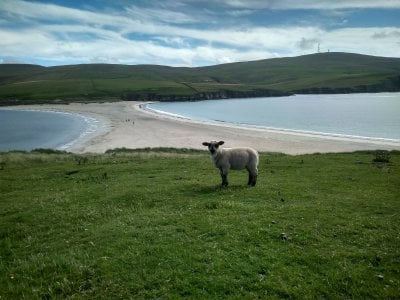
walked across the tombolo at St Ninian's Isle, and made a boat trip to Whalsay where we did a walk round the coast and bumped into some Neolithic ruins humbly resting among the heather.
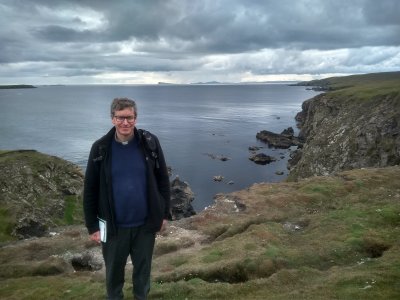
I was very struck by the beauty of the isles: the breathtaking views of sea-battered cliffs; the vast, open landscapes and the almost Caribbean-like beaches: I walked across many of them barefoot and even dared to dip my feet into the water - a pleasantly numbing experience.
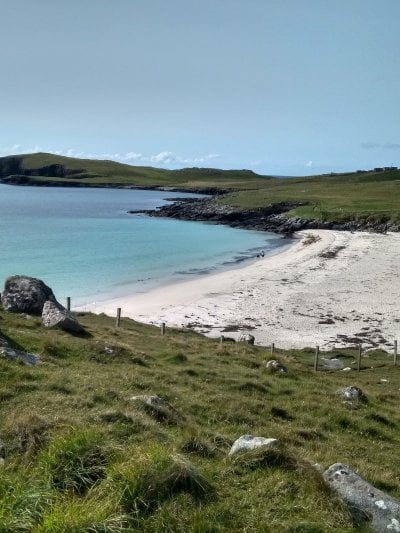
I was particularly drawn by the beauty of Shetland's wildlife - the soaring skuas and the gliding gulls, but especially the pretty puffins;

the ponies too!
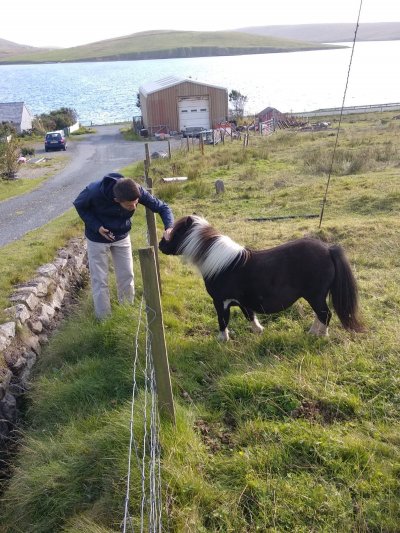
I remember from my childhood that I got to go on one as my neighbour owned a horse stable and lots of horses; it was amazing to see the various colours of sheep I hadn't seen before. Most of them ran away from me but some were curious when I would pass through their field praying the rosary.
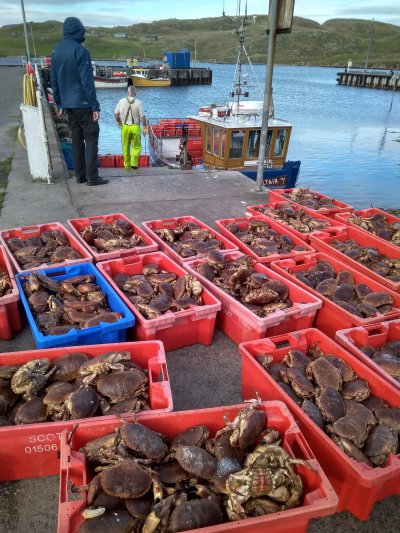
Some of the highlights of my time there were a visit to the impressive volcanic cliffs at Eshaness with Teresa, a Polish parishioner. We had a marvellous day of long walks along the coast at Hillswick and a picnic to give us strength for another walk up Eshaness.

Another great day was going out with Willie to see the Old Croft House Museum, followed by fish and chips for lunch down at Sumburgh. And how could I forget Marianne's exquisite culinary concoctions - the spicy stew with chestnuts and the marvellous Mexican burritos!
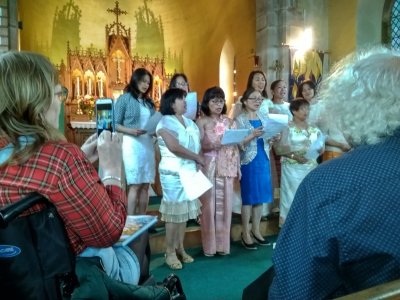
My last two days were particularly memorable and a fitting way to conclude my time on Shetland. On Saturday 8th September we had a fundraising concert for students in Ghana and everyone in the parish played a huge role in making it such a success. There were Philippine songs, a piece from Handel's Messiah, recited poetry, Polish hymns, English folk songs and Spanish guitar. Following the concert, we had a great feast in the parish rooms which was like a taste of heaven itself: all nations gathered together around the table enjoying a plethora of dishes - fish chowder, butternut squash soup, a whale-sized salmon surrounded by a colourful salad, coconut and mango cake, caramel rice pudding and Polish donuts, just to name a few of them. Some of the leftovers made it into our lunchboxes for the next day when we went sailing around the island of Papa Little.

After Mass on Sunday we drove out to Aith harbour where we set out on our sail under a grey sky. Under the brilliant direction of Captain Marsali we moved gracefully on the peaceful waters with a crew of four and a dog.
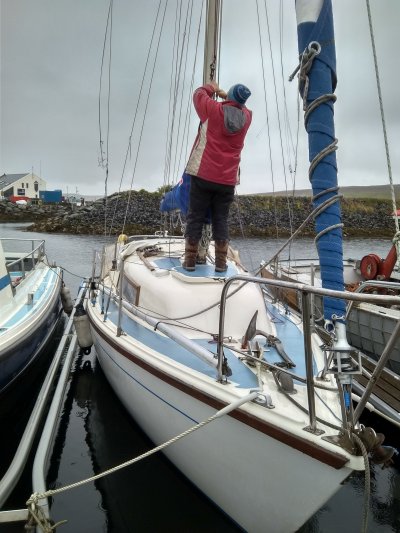

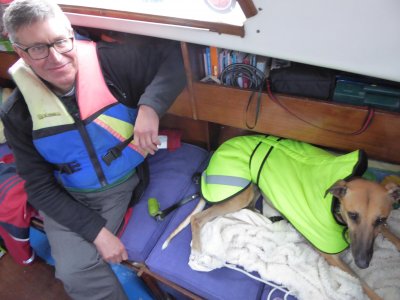
As the waters got rougher at the top of the island and the rain came on - as had been forecast - and the wind picked up, we were forced to return in zigzags until the sails came down and the engine was turned on. We did manage to have a bite to eat and a cup of hot chocolate before we got drenched.
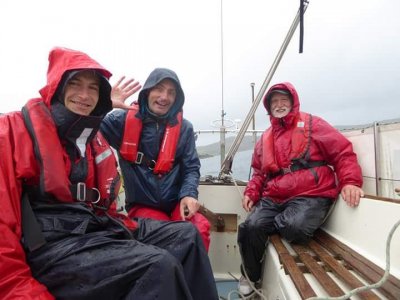
To this day I still think about the experiences I had on Shetland, the people I met and all the graces received. It was a very special part of my formation to the priesthood and would love the idea of coming back to serve them there one day in the future. I give thanks to God for all of you who made that time so blessed and joyful. Shetland will be in my heart always.
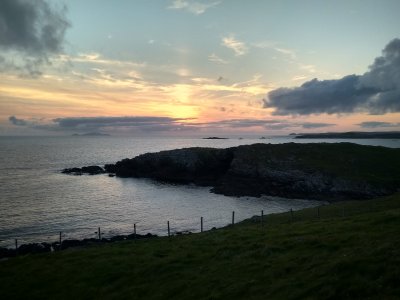
Concert for Africa
12 Sep 2018
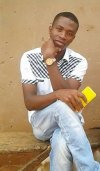
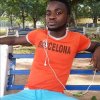
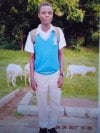
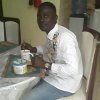
St Margaret's pews were well filled for the parish's first Fundraising Concert to sponsor four Ghanaian students through further education.

The four young men are all known to Father Ambrose through his work in Africa, and cannot continue as students without help. The former bursary scheme in Ghana has now been closed, and when the students contacted Father Ambrose to ask for support, parishioners were keen to help.
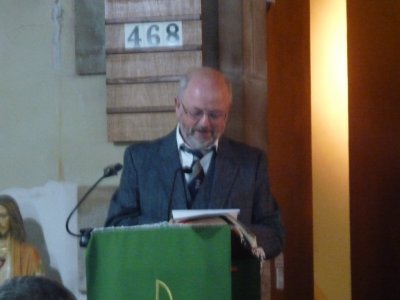
The concert was organised by Celia Smith and Brian Nugent, and the programme had something for everyone. There were five congregational hymns chosen by members of the parish, each one introduced with an account of why it was special to that person.

Regina Schmidt, accompanied by Peter Haviland, sang the beautiful I know that my Redeemer Liveth, and later did a medley of short religious pieces with seminarian Christopher Doig.

The Polish group did two favourite hymns, Abba Ojcze and Barka (well known in the English version, Lord you have come to the Seashore).

Young player Ania Skindzier joined them on the clarinet, along with Christopher on the guitar. Christopher showed his solo guitar skills with two Spanish pieces, and David Davies made everyone smile with some Lancashire school favourites and unaccompanied ballads. Joyce Davies read a dialect prose piece by Grace Barnes, Leaving Lerwick Harbour, and Marsali Taylor read three short religious poems.
 .
.
Toes tapped in the pews as the splendidly dressed Filipina group sang Ang Taning Alay Ko and Magpasalamat Kayo Sa Paginoon.
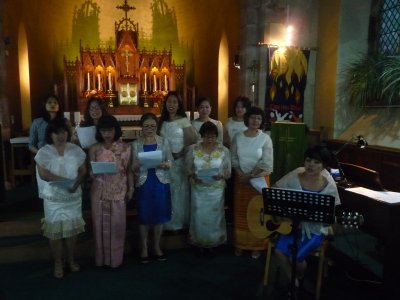
The last congregational hymn was Walk with me, O my Lord, and Katie Hatfield, introducing it, got murmurs of agreement when she said that it made her think of our parish and these four young men in Ghana, walking together in faith.

Finally, Father Ambrose and Christopher Doig led the singing of the Salve Regina, and candles were lit for the four students.
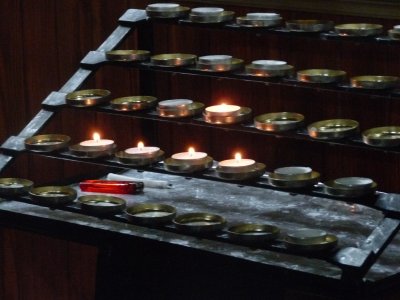
The concert was followed by a magnificent 'bring and share' feast in the parish rooms, with a huge salmon as a centrepiece, and a variety of delicious savouries and sweets. The total raised by the evening was One Thousand Seven Hundred and Thirty Three Pounds (more than Ten Thousand Ghana Cedis). The fund will be ongoing, as each student needs about Eight Hundred Pounds per year to continue in education - all donations welcomed!
If you would like to contribute, please see further information on the 'Africa Fund' page.
The Herring Boom
10 Jun 2018

The North Pole Mission had been set up c. 1855 by Pope Pius IX "for the evangelisation of the people lying within the frozen regions towards the North Pole." There were never many clergy assigned to it. After the departure of Fr Djunkowsky (who reverted to Russian Orthodoxy in order to reclaim his ancestral estates after a brief and unhappy marriage)there were eight priests: Very Rev Bernard Bernard, the Apostolic Prefect, who was based in Wick from 1861-64, then Copenhagen from 1864-68; Rev A. Boller in Tromso, and Rev E. Maesfrancx at Altengaard, both in Lapland; Rev G. Bauer and J.M. Convers at Thorshaven in the Faroe Islands; Rev J.B. Baudoin and E.M. Dekiere at Reykjavik in Iceland; and Rev Theophilus Verstraeten at Lerwick in the Shetland Islands. Many of them were Belgian. This ambitious missionary endeavour came to an end in 1868 when the territory was broken up along national lines.

The second Prefect Apostolic, Abbe Bernard Bernard, now became Prefect Apostolic of a new Norwegian Mission, and Shetland was handed back to the Vicar Apostolic of the Northern District of Scotland. Within a few years the Scottish hierarchy was restored and from 1878 Shetland became part of the Diocese of Aberdeen, to which it still belongs. Fr Verstraeten transferred to the diocesan clergy for the last three years of his ministry.
The number of Catholics in Shetland was increasing. When Fr Verstraeten arrived his mission was mainly to fishermen on their way to the fishing grounds around Shetland and out towards Iceland. But from the 1870s Shetland was caught up in the herring boom which lasted until the First World War. The main centres were at Baltasound in Unst, Lerwick and Scalloway.
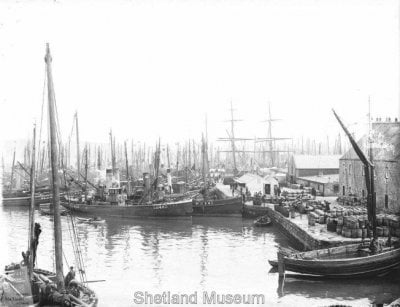
The Herring season began at Johnsmas, - 24th June, the Feast of John the Baptist - when the Dutch fishing fleet arrived in Lerwick harbour. The island of Bressay gave shelter to the Mainland at this point, and up to a thousand boats could converge here from all parts of northern Europe. Much of the subsequent catch was landed at Shetland ports and the herring gutted and packed with salt into barrels. At the peak of the trade, hundreds of thousands of barrels of salted herring were exported to Germany and Russia each year. With this herring boom came a migrant band of fisherwomen who worked their way round the north coast of Scotland, and down the east coast of England, following the fishing fleet.
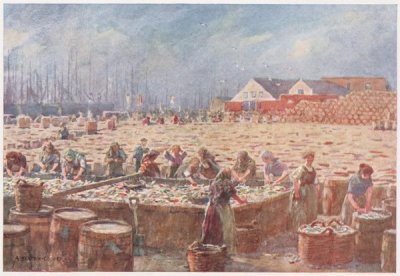
Herring fisherwomen at Yarmouth
Many of these fisherwomen were Irish and Catholic. Margaret Cruickshank, who lived for most of the year in London, often visited Shetland during the herring season and was struck by the cramped nature of their Sunday worship. After the death of Fr Verstraeten there was no resident Catholic priest in Shetland but the islands were served occasionally by priests coming from Orkney, Wick and Aberdeen. The old cellar-chapel of St Anne in Lerwick, which Fr Djunkowsky had boasted could seat a hundred, in reality could seat only fifty, and in the 1880s the Catholic community had moved their services to the newly built Lerwick Town Hall.
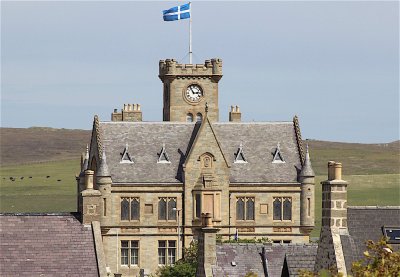
Margaret Cruickshank raised money - even from the pennies of the fisherwomen themselves - to build a more permanent Catholic Chapel in Lerwick. She died on 26th December 1910, just seven months before the new Church was opened, and is commemorated by a monument beneath one of the windows.
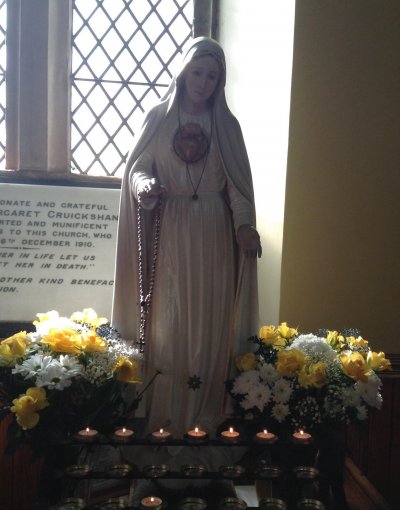
The official dedication of our church is to the Sacred Heart and St Margaret, but the fact that almost from the beginning the dedication has been reversed witnesses to the affection shown to this early benefactor. The North Pole Mission had been placed under the patronage of the Sacred Heart. Perhaps that is the clue to the double dedication? More recently, another monument has been added opposite Margaret Cruickshank's to commemorate Fr Theophilus Verstraeten.
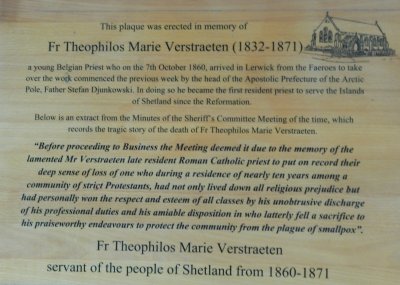
He was technically an 'Apostolic Missioner' but is remembered as Shetland's first resident Parish Priest. Apart from a brief appointment after the opening of St Margaret's Church in 1911, there would not be another resident priest in Shetland until 1954.

